ICRANet
The 2014 Scientific Report
Presented to
The Scientific Committee
by
Remo Ruffini
Director of ICRANet
ICRANet has been created by a law of the Italian Government, ratified unanimously by the Italian Parliament and signed by the President of the Republic of Italy on February 10 th 2005. The Republic of Armenia, the Republic of Italy, the Vatican State, ICRA, the University of Arizona and the Stanford University have been the Founding Members. All of them have ratified the Statute of ICRANet (see Enclosure 1). On September 12 th 2005 the Board of Governors was established and had its first meeting. Professors Remo Ruffini and Fang Li-Zhi were appointed respectively Director and Chairman of the Board. On December 19 th 2006 the Scientific Committee was established and had its first meeting in Washington DC. Prof. Riccardo Giacconi was appointed Chairman and John Mester Co-Chairman. On September 21 st 2005 the Director of ICRANet signed with the Ambassador of Brazil Dante Coelho De Lima the adhesion of Brazil to ICRANet. The entrance of Brazil, requested by the President of Brazil Luiz Ignácio Lula Da Silva has been unanimously ratified by the Brazilian Parliament. On February 2009 the board renewed the position of Prof. Fang Li-Zhi as the Chairman of the Board. On December 2009 the Scientific Committee renewed the position of Prof. Riccardo Giacconi as the Chairman of the Committee. On February 2010 the board renewed the position of Prof. Remo Ruffini as the Director of the ICRANet. On August 12 th , 2011 the President of Brazil Dilma Rousseff signed the entrance of Brazil in ICRANet. On October 15 th , 2012, following the death of Prof. Fang LiZhi, Prof. Francis Everitt was appointed Chairman of the Board and Prof. XiaoHui Fan and Prof. ShuFang Su were indicated as temporary substitutes of Prof. Fang. On June 12 th , 2013, following the completion of his second mandate, Prof. Riccardo Giacconi has resigned as Chairman of the Scientific Committee on the completion of his 81 st birthday . Prof. Jo ã o Braga was then appointed Chairman of the Scientific Committee and Prof. Massimo Della Valle was appointed Co-Chairman (details on http://www.icranet.org/ ). In December 2013, during the visit at the University of Arizona of Prof. Remo Ruffini, Director of ICRANet, it was agreed with the Dean of the University of A rizona to appoint Prof. XiaoHui Fan as the successor of Prof. Fang LiZhi in representing the University of Arizona in the ICRANet Board. In May 2014 Prof. João Braga resigned from the Scientific Committee. ICRANet launched a n open call, with the support of the Brazilian Physical Society and of the Brazilian Astronomical Society, for a new representative of Brazil in the Scientific Committee. The call selected Prof. Kepler de Souza Oliveira Filho (see Enclosure 2) . This candidature was submitted to MCTI (Brazilian Minister of Science and Technology and Innovations). In the meantime Prof. Kepler was appointed vice-president of the Brazilian Astronomical Society, which added to his already duties as Chairman of the CNPq Committee for Astronomy and Physics, making his operational activities within ICRANet Scientific Committee not possible. In August 2014 Dr. Ademar Seabra Da Cruz of Itamaraty has been appointed as the head representative of Brazil in the ICRANet BoardICRANet is still waiting for the additional nomination of the representatives of the MCTI in the Board and in the Scientific Committee.
During 2014, we have:
-
adjourned and recruited the Scientific Staff of ICRANet, including the adjunct Faculty, Lecturers, Research Scientists, Visiting Scientists; adjourned and recruited the Administrative Staff of ICRANet;
-
further developed the project of the Brazilian Science Data Center (BSDC) (see Enclosure 2);
-
fostered the operations of the Seats of ICRANet in Nice at Villa Ratti, in Yerevan at the National Academy of Sciences and in Brazil at CBPF (see Enclosure 3);
-
prepared the proceedings of the meetings of 2013 and organized meetings and PhD schools (see Enclosure 4);
-
updated and signed co-operation agreements with Universities and Research Centers, including ASI (Italian Space Agency, Italy), BSU (Belarusian State University, Belarus), CAPES (Brazilian Fed. Agency for Support and Evaluation of Grad. Education), CBPF (Brazil), State Government of Ceará (Brazil), CNR (National Research Council, Italy), ENEA (National Agency for new technologies, energy and the economic sustainable development, Italy), FAPERJ (Fundação Carlos Chagas Filho de Amparo à Pesquisa do Estado do Rio de Janeiro, Brazil), GARR (Italy), ICTP (The Abdus Salam International Center for Theoretical Physics, Italy), IHEP (Institute of High Energy Physics, Chinese Academy of Sciences, China), IHES (Institut des Hautes Études Scientifiques, France), INFN (National Institute for Nuclear Physics, Italy), INPE (Instituto Nacional de Pesquisas Espaciais, Brasil), ITA (Instituto Tecnológico de Aeronáutica, Brazil), LeCosPa (Leung Center for Cosmology and Particle Astrophysics, Taiwan), NASB (National Academy of Sciences, Belarus), NAS RA (National Academy of Science, Armenia), Nice University Sophia Antipolis (France), Pescara University “D’Annunzio” (Italy), SCSA (State Committee of Science of Armenia), UAM (Universidad Autónoma Metropolitana, México), UERJ (Rio de Janeiro State University, Brazil), UFF (Universidade Federal Fluminense, Brazil), UFPB (Universidade Federal da Paraíba, Brazil), UFPE (Universidade Federal de Pernambuco, Brazil), UFRGS (Universidade Federal do Rio Grande do Sul, Brazil), UFSC (Universidade Federal de Santa Catarina, Brazil), UIS (Universidad Industrial de Santander, Colombia), UNAM (Universidad Nacional Autonoma De Mexico), UNIFEI (Universidade Federal de Itajubà, Brazil), University of Rome “Sapienza” (Italy), UNS (Universidad Nacional del Sur, Argentina) (see Enclosure 5);
-
recruited new students, organized the teaching programs and the Thesis works of the International Relativistic Astrophysics Doctoral program (IRAP-PhD), jointly sponsored by ICRANet and ICRA in collaboration with AEI – Albert Einstein Institute – Potsdam (Germany), Bremen University (Germany), Carl von Ossietzky University of Oldenburg (Germany), CBPF – Brazilian Centre for Physics Research (Brazil), Ferrara University (Italy), IHES (France), Indian centre for space physics (India), INPE (Instituto Nacional de Pesquisas Espaciais, Brasil), Nice University Sophia Antipolis (France), Observatory of the Côte d'Azur (France), Rome University – “Sapienza” (Italy), Savoie University (France), Shanghai Astronomical Observatory (China), Stockholm University (Sweden), Tartu Observatory (Estonia) (see Enclosure 6);
-
developed the Erasmus Mundus program of the European Commission and recruited additional nine students (see Enclosure 7);
-
implemented the call for the first cycle of the CAPES-ICRANet program for PhD students, Post-Doc Researchers and Visiting professors, and completed on August 30th the call for the second cycle which is pending approval by CAPES (see Enclosure 8);
-
followed the project for the ICRANet Center at the Cassino da Urca in Rio de Janeiro, Brazil (see Enclosure 9);
-
fostered the lines of research and publication activities which are the objects of the present report.
1) The ICRANet Staff
In the establishment of the ICRANet Scientific Staff we have followed the previously adopted successful strategy:
-
To appoint talented young scientists, as well as senior scientists who have already contributed significantly to those areas which led to the establishment of ICRANet.
-
To create an adjunct Faculty with scientists who have made internationally recognized contributions to the field of relativistic astrophysics and whose research interests are closely related to those of ICRANet. These scientists spend from one to six months at the Pescara Center, thereby linking it with their home institutions.
-
To develop a program of Lecturers, Research Scientists and Visiting Scientists, necessary to the research and academic activities of the Center.
The purpose of this strategy is to establish strong connections with the most advanced international Research Centers. It also promotes the vital connections between the ICRANet Member Institutions. The Curricula of the ICRANet Staff are given in the Accompanying Document “ The ICRANet Staff, Visiting Scientists and Graduate Students at the Pescara Center ”
2) The Collaboration with Brazil (see Enclos. 2)
The collaboration with Brazil has been characterized by a successful program with graduate students, researchers, post-docs, and senior visitor scientists both in Europe and in Brazil (see also point 8 below), including the initiative to establish the ICRANet Brazilian Science Data Center (BSDC). Agreements have been signed between ICRANet and ten Universities and Research Centers in Brazil (see point 5 below). Activities are proceeding successfully, despite some recent tensions with some colleagues at CBPF. ICRANet sincerely considers such tensions the results of a misunderstanding.
3) Inauguration of the Seat in Nice at Villa Ratti, in Yerevan at the National Academy of Sciences and in Brazil at CBPF (see Enclos. 3)
We have completed the restructuring of Villa Ratti for the ICRANet Seat in Nice. We been very pleased to receive the invitation by the Municipality of Nice to open ICRANet activities in France, in order to maximize our contacts with other European Countries and more generally with Countries all over the world. We are planning the inauguration in the first semester of 201 5 . The appeal for the town of Nice and his surroundings, the existence of a modern and efficient airport, the electronic backbones for internet communications are all important elements which add to the decision of the Nice Municipality to offer the historical Villa Ratti as a seat for ICRANet in Nice. Since, an important finding of wall paintings of circa 1750 occurred in the Villa and they have all been restored . The headquarter of the IRAP-PhD program is in Villa Ratti. We were pleased to have, a mong the first visitors of the opened ICRANet Seat in Villa Ratti, the Nobel Laureate Murray Gell-Mann as well as Prof. Felix Aharonian, Prof. Thibault Damour and Prof. Tom Kibble. We have also started the activities of the ICRANet Seat in Armenia, at the Headquarter of the National Academy of Sciences in Yerevan and at the Byurakan Observatory. The seat agreement has just been approved by the President of Armenia. Important has been the attribution by the Armenian State Science Committee of five positions: three researchers, one technical support and one secretariat. The 1 st ICRANet Scientific Meeting in Armenia has been held in Yerevan from June 30 th to July 4 th , 2014 (see also point 4 below). We have also started the ICRANet Seat in Rio de Janeiro at CBPF and possibly expanding at the Cassino da Urca.
4) International Meetings (see Enclos. 4)
We have completed the proceedings of:
-
13 th Italian-Korean Symposium, Seoul, South Korea, July 15-19, 2013 (proceedings published in the Journal of the Korean Physical Society, Vol. 65, No. 6, September 2014).
-
XIII Marcel Grossmann Meeting, Stockholm, Sweden July 1-7, 2012 (proceedings edited by R.T. Jantzen, K. Rosquist, R. Ruffini, World Scientific, Singapore, 2014).
We have also organized th e following meetings:
-
IRAP-PhD Nice Winter School, Nice, France, February 23 – March 2, 2014.
-
100 th Anniversary of the Birth of Zel’dovich, Minsk, Belarus, March 10 – 14, 2014 (Proceedings on Astronomy Report, 2014, in press).
-
Search for Life beyond the Solar System, Tucson, Arizona (USA), March 16 – 21, 2014.
-
IRAP-PhD Les Houches School, Les Houches, France, May 11 – 16, 2014 (Proceedings by World Scientific, 2015, in press).
-
1 st Scientific ICRANet Meeting in Armenia, Yerevan, Armenia, June 30 – July 4, 2014.
-
3 rd Bego Rencontres, Nice, France, September 8 – 19, 2014.
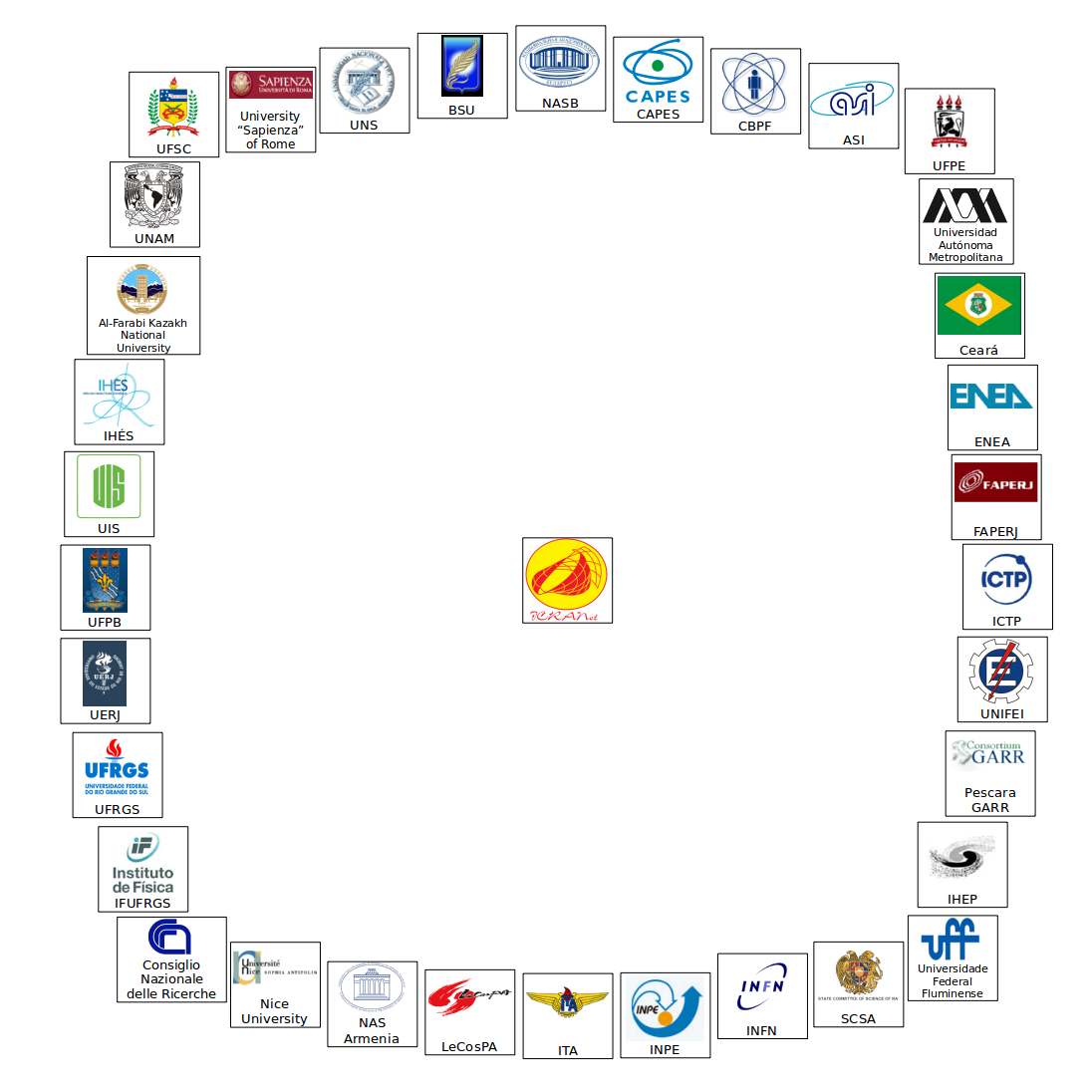
Figure 1
5) Scientific Agreements (see Enclos. 5)
The following Agreements have been signed, updated and renewed in 2014 by the Director (see Fig. 1):
-
ASI (Italian Space Agency, Italy),
-
BSU (Belarusian State University, Belarus),
-
CAPES (Brazilian Fed. Agency for Support and Evaluation of Grad. Education),
-
CBPF (Brazil),
-
State Government of Ceará (Brazil),
-
CNR (National Research Council, Italy)
-
ENEA (National Agency for new technologies, energy and the economic sustainable development, Italy),
-
FAPERJ (Fundação Carlos Chagas Filho de Amparo à Pesquisa do Estado do Rio de Janeiro, Brazil),
-
GARR (Italy),
-
ICTP (The Abdus Salam International Center for Theoretical Physics, Italy),
-
IHEP (Institute of High Energy Physics, Chinese Academy of Sciences, China),
-
IHES (Institut des Hautes Études Scientifiques, France),
-
INFN (National Institute for Nuclear Physics, Italy),
-
INPE (Instituto Nacional de Pesquisas Espaciais, Brasil),
-
ITA (Instituto Tecnológico de Aeronáutica, Brazil),
-
LeCosPa (Leung Center for Cosmology and Particle Astrophysics, Taiwan),
-
NASB (National Academy of Sciences, Belarus),
-
NAS RA (National Academy of Science, Armenia),
-
Nice University Sophia Antipolis (France),
-
Pescara University “D’Annunzio” (Italy),
-
SCSA (State Committee of Science of Armenia),
-
UAM (Universidad Autónoma Metropolitana, México),
-
UERJ (Rio de Janeiro State University, Brazil),
-
UFF (Universidade Federal Fluminense, Brazil),
-
UFPB (Universidade Federal da Paraíba, Brazil),
-
UFPE (Universidade Federal de Pernambuco, Brazil),
-
UFRGS (Universidade Federal do Rio Grande do Sul, Brazil),
-
UFSC (Universidade Federal de Santa Catarina, Brazil),
-
UIS (Universidad Industrial de Santander, Colombia),
-
UNAM (Universidad Nacional Autonoma De Mexico),
-
UNIFEI (Universidade Federal de Itajubà, Brazil),
-
University of Rome “Sapienza” (Italy),
-
UNS (Universidad Nacional del Sur, Argentina).
These collaborations are crucial in order to give ICRANet scientists the possibility to give courses and lectures in the Universities and, vice versa, to provide to the Faculty of such Universities the opportunity to spend research periods in ICRANet institutions.
6) The International Relativistic Astrophysics Ph.D. (IRAP-PhD) program (see Enclos. 6)
One of the major success of ICRANet has been to participate in the International competition of the Erasmus Mundus Ph.D. program and the starting of this program from the 2010 (see Fig. 2). The participating institutions are:
-
AEI – Albert Einstein Institute – Potsdam (Germany)
-
Bremen University (Germany)
-
Carl von Ossietzky University of Oldenburg (Germany)
-
CBPF – Brazilian Centre for Physics Research (Brazil)
-
Ferrara University (Italy)
-
Indian centre for space physics (India)
-
INPE (Instituto Nacional de Pesquisas Espaciais, Brasil)
-
Institut Hautes Etudes Scientifiques – IHES (France)
-
Nice University Sophia Antipolis (France)
-
Observatory of the Côte d'Azur (France)
-
Rome University – “Sapienza” (Italy)
-
Savoie University (France)
-
Shanghai Astronomical Observatory (China)
-
Stockholm University (Sweden)
-
Tartu Observatory (Estonia)
The IRAP PHD program intends to create conditions for high level education in Astrophysics mainly in Europe to create a new generation of leading scientists in the region. No single university in Europe today has the expertise required to attain this ambitious goal by itself. For this reason we have identified universities which offers a very large complementarity expertise. The students admitted and currently following courses and doing research in such a program are given in the following:
Third Cycle 2004-07
-Chiappinelli Anna France
-Cianfrani Francesco Italy
-Guida Roberto Italy
-Rotondo Michael Italy
-Vereshchagin Gregory Belarus
-Yegoryan Gegham Armenia
Fourth Cycle 2005-08
-Battisti Marco Valerio Italy
-Dainotti Maria.Giovanna Italy
-Khachatryan Harutyun Armenia
-Lecian Orchidea Maria Italy
-Pizzi Marco Italy
-Pompi Francesca Italy
Fifth Cycle 2006-09
-Caito Letizia Italy
-De Barros Gustavo, Brasil
-Minazzoli Olivier, Switzerland
-Patricelli Barbara, Italy
-Rangel Lemos Luis Juracy, Brasil
-Rueda Hernandez Jorge Armando Colombia
Sixth Cycle 2007-2010
-Ferroni Valerio Italy
-Izzo Luca Italy
-Kanaan Chadia Lebanon
-Pugliese Daniela Italy
-Siutsou Ivan Belarus
-Sigismondi Costantino Italy
Seventh Cycle 2008-2011
-Belvedere Riccardo Italy
-Ceccobello Chiara Italy
-Ferrara Walter Italy
-Ferrari Francesca Italy
-Han Wenbiao China
-Luongo Orlando Italy
-Pandolfi Stefania Italy
-Taj Safia Pakistan
Eight Cycle 2009-2012
-Boshkayev Kuantay Kazakhstan
-Bravetti Alessandro Italy
-Ejlli Damian Albanian
-Fermani Paolo Italian
-Haney Maria German
-Menegoni Eloisa Italy
-Sahakyan Narek Armenia
-Saini Sahil Indian
Ninth Cycle 2010-2013 (including Erasmus Mundus call)
-Arguelles Carlos Argentina
-Benetti Micol Italy
-Muccino Marco Italy
-Baranov Andrey Russia
-Benedetti Alberto Italian
-Dutta Parikshit India
-Fleig Philipp Germany
-Gruber Christine Austria
-Liccardo Vincenzo Italy
-Machado De Oliveira Fraga Bernardo Brazil
-Martins De Carvalho Sheyse Brazil
-Penacchioni Ana Virginia Argentina
-Valsan Vineeth India
Tenth Cycle 2011-2014 (including Erasmus Mundus call)
-Cáceres Uribe, Diego Leonardo Colombia
-Raponi, Andrea Italy
-Wang, Yu China
-Begue, Damien France
-Dereli, Husne Turkey
-Gregoris, Daniele Italy
-Iyyani, Shabnam Syamsunder India
-Pereira, Jonas Pedro Brazil
-Pisani, Giovanni Italy
-Rakshit, Suvendu India
-Sversut Arsioli, Bruno Brazil
-Wu, Yuanbin China
Eleventh Cycle 2012-2015 (including Erasmus Mundus call)
-Barbarino, Cristina Italy
-Bardho, Onelda Albania
-Cipolletta, Federico Italy
-Dichiara, Simone Italy
-Enderli, Maxime France
-Filina, Anastasia Russia
-Galstyan, Irina Armenia
-Gomes De Oliveira, Fernanda Brazil
-Khorrami, Zeinab Iran
-Ludwig, Hendrik Germany
-Sawant, Disha India
-Strobel, Eckhard Germany
Twelfth Cycle 2013-2016 (including Erasmus Mundus call and CAPES-ICRANet call)
-Ahlén, Olof Sweden
-Becerra Bayona, Laura Colombia
-Brandt, Carlos Henrique Brazil
-Carvalho, Gabriel Brazil
-Gómez, Gabriel Colombia
-Harutyunyan, Vahagn Armenia
-Kovacevic, Milos Serbia
-Li, Liang China
-Lisakov, Sergey Russia
-Maiolino, Tais Brazil
-Pereira Lobo, Iarley Brazil
-Sridhar, Srivatsan India
-Stahl, Clément France
-Yang Xiaofeng China
Thirteenth Cycle 2014-2017 (including Erasmus Mundus call and CAPES-ICRANet call)
-Aimuratov, Yerlan Kazakhstan
-Chang, Yu-Ling Taiwan
-Delgado, Camilo Colombia
-Efremov, Pavel Ukraine
-Gardai Collodel, Lucas Brazil
-Karlica, Mile Croatia
-Krut, Andreas Germany
-Martinez Aviles, Gerardo Mexico
-Moradi, Rahim Iran
-Otoniel da Silva, Edson Brazil
-Silva de Araújo Sadovski, Guilherme Brazil
-Ramos Cardoso, Tatiana Brazil
-Rodriguez Ruiz, Jose Fernando Colombia
We enclose the Posters of the IRAP-PhD for all the above cycles.
7) The Erasmus Mundus Ph.D. program (see Enclos. 7)
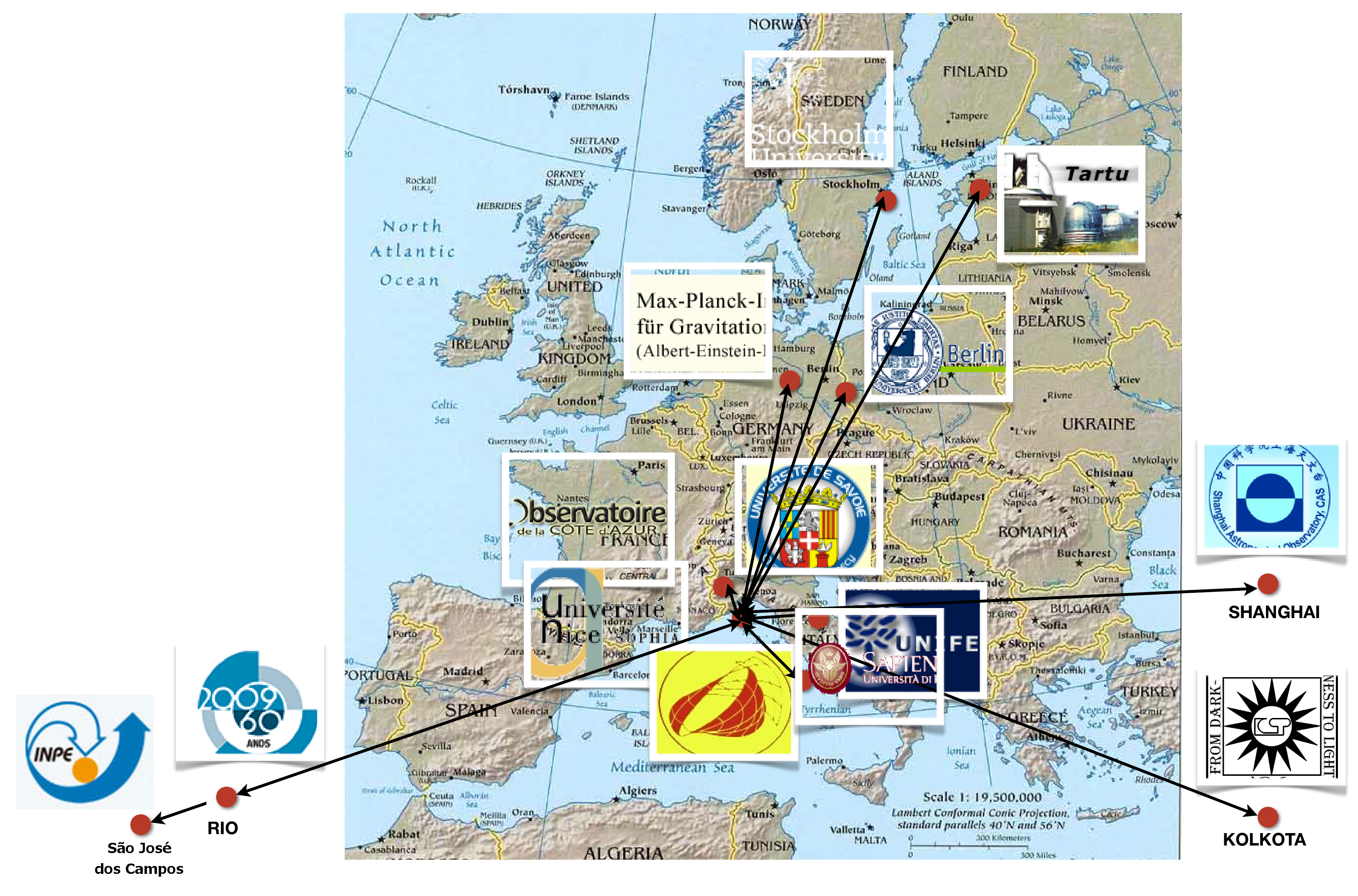
Figure 2
Each student admitted to the Erasmus Mundus program of the IRAP Ph.D. is part of a team inside one of the laboratories of the consortium. Each year they have the opportunity to visit the other laboratories of the consortium and enlighten themselves with new topics in the forefront research from world leading experts. In this way the students come in direct contact with some of the leading scientists in the world working in General Relativity, Relativistic Astrophysics and in Quantum Field Theory. In addition to the theoretical centers, we associate experimental and observational centers. This will provide an opportunity to the Ph.D students to obtain a complete education in theoretical relativistic astrophysics and also an experience on how to carry out a specific astrophysical mission.
All the institutions participating in IRAP PhD have an extensive experience in international collaborations including visiting professors, post-doctoral researchers and training of Ph.D. students. All of our partners have enrolled Ph.D. students inside their laboratories in various aspects of astrophysics.
8) CAPES-ICRANet Program (see Enclos. 8)
Following the Memorandum of Understanding signed in 2012 with CAPES, we started the CAPES-ICRANet Program on Relativistic Astrophysics and Cosmology to promote the Collaboration between Brazilian and European scientists with five major actions: 1) Fellowships for Brazilian graduate students in the IRAP-PhD program; 2) Senior European scientists visiting Brazil for up to 3 months per year for three years; 3) Senior Brazilian scientists visiting ICRANet seats in Asia and Europe for up to 5 months in a year; 4) Postdoctoral Fellowships for International candidates in ICRANet seats, Scientific Institutions associated to ICRANet, and Institutions with scientists associated to ICRANet, both in Europe and Brazil; 5) Organization of workshops and outreach programs. The first cycle of the program started in September 2013, and on August 30 th , 201 4 there was the deadline for the call for the second cycle of the program . Since September 18 th , 2014, the CAPES-ICRANet program has been suspended. ICRANet has presented the candidatures for the second cycle of the above mentioned five actions, having received all the acceptances from the corresponding host institutions, and is looking for CAPES scrutiny.
9) Project for the ICRANet Center at Cassino da Urca (see Enclos. 9)
We have followed the architectural project for the ICRANet Center at the Cassino da Urca in Rio de Janeiro, Brazil.
10) Lines of research
We turn now to the research activity of ICRANet, which by Statute addresses the developments of research in Astrophysics in the theoretical framework of Albert Einstein’s theories of special and general relativity within the limits of their observational and experimental verifications. Thanks to an unprecedented developments of observational techniques from the ground, from Space, and even in underground experiments in astroparticle physics, we are today capturing astrophysical signals from all over the universe never before conceived and received in human history. The Einstein theory of relativity for many years was relegated to the boundaries of physics, and attracted mainly interest in the mathematics. Since 50 years it has become the authentic conceptual and theoretical “backbone” of the exponentially growing field of relativistic astrophysics in view of the very impressive information and data arriving from all over our universe: in our galaxy, all the way to the farthest objects observed at z = 8 and to the Big bang.
There is a very well recognized principle in scientific research that, granted the freedom of thinking and of performing observational or experimental activities, only through the complementary fulfillment of both these aspects, in a collective effort, science progress es . S uch a principle is not confined to Relativistic Astrophysics: it generally applies to all scientific activities. In particular, any new idea should be supported by observational and experimental evidence, prior to be presented as a credible alternative to already existing and tested theories. This principle specially applies to the case of Maxwell theory of electrodynamics and Einstein theories of special and general relativity. They have become the best tested theories in science, they are still evolving, and they are at the basis of the technological developments which make possible our daily life. ICRANet considers this principle at the very basis of its activities. At this point , it should be mentioned that in recent months there has been a debate at CBPF on the role of free thinking and of experimental and observational activities in science. We sincerely wish that these differences will vanish in the near future for the well being of students, research and scientific progress.
In the Reports of previous years, as a testimonial of these developments, I enclosed the paper “The Ergosphere and Dyadosphere of Black Holes” which has appeared in “The Kerr spacetime”, edited by David L. Wiltshire, Matt Visser and Susan M. Scott (Cambridge University Press, 2009). In it, I traced the exciting developments, which started with the understanding on the nuclear evolutions of stars, and had then led to the discovery of neutron stars, and through the work of Riccardo Giacconi and colleagues, to the first identification of a black hole in our galaxy. I also enclosed the paper “Moments with Yakov Borisovich Zeldovich” (appeared in the Proceedings of the International Conference “The Sun, the Stars, the Universe, and General Relativity” in honor of Ya.B. Zel’dovich's 95th Anniversary, Editors R. Ruffini and G.V. Vereshchagin, AIP Conference Proceedings, Vol. 1205 (2010) p. 1-10), recalling some of the crucial moments in the developments of relativistic astrophysics in Soviet Union around the historical figure of Ya.B. Zel’dovich. It is also appropriate to mention that ICR ANet organize d an International conference in honor of Ya. B. Zel’dovich 100 th Anniversary in Minsk (Belaurs) on March 10-14, 2014. I hereby enclose the paper “ Black Holes, Supernovae and Gamma Ray Bursts ” which I published in the Proceedings of the MG13 meeting (edited by R.T. Jantzen, K. Rosquist, R. Ruffini, World Scientific, Singapore, 2014).
I recalled the growth of scientific research from the initial o ne (see Fig. 3), which was based on three major contributions :
-
The knowledge made possible by general relativity and especially by the Kerr solution and its electrodynamical generalization in the Kerr-Newman black hole (see e.g. the recent development of the dyadotorus concept, Fig. 4).
-
The great knowledge gained in relativistic quantum field theories originating from particle accelerators, colliders and nuclear reactors from laboratories distributed worldwide (see e.g. the recent developments at CERN, Fig. 5).
-
The splendid facilities orbiting in space, from the Chandra to the XMM, to the Swift and Ferm i missions as well as many other satellites, the VLT and Keck telescopes on the ground, as well as the radio telescope arrays offer us the possibility, for the first time, of the observations of the most transient and energetic sources in the universe: the Gamma-Ray Bursts (GRBs) (see e.g. the recent developments thanks to additional scientific missions, Fig. 6).
In the previous years Reports I have shown that, thanks to a fortunate number of events and conceptual and scientific resonances, a marked evolution of these topics had occurred. From these premises, new fields of research had sprouted up at the ICRANet Center in Pescara, at ICRA in Rome and at the other Member Institutions, especially thanks to the development of the IRAP-PhD program (see point 7 above) and to the many scientists and visitors participating in the ICRANet programs (see Figs. 7, 8, 9a and 9b).
I turn now to a summary of the current activities presented in full details in Volume 2 and Volume 3.
Gamma-rays and Neutrinos from Cosmic Accelerators ( Page 1 ).
Particularly important is this report, which summarizes the activities traditionally carried on by the ICRANet Armenian Scientists in the MAGIC and HESS collaborations. This topic was motivated by Prof. Felix Aharonian joining ICRANet as representative of Armenia in the Scientific Committee and by his appointment as Adjunct Professor of ICRANet on the Benjamin Jegischewitsch Markarjan Chair. Many of the observational work done by Prof. Aharonian are crucial for the theoretical understanding of the ultra high energy sources. Prof. Aharonian started also his collaboration with the IRAP PhD program where he is following the thesis of graduate students as thesis advisor. The evolution and future prospects on the analysis of the high-energy gamma-ray emission are presented in this report by Prof. Aharonian and Dr. Sahakyan.
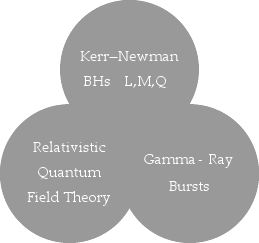
Figure 3
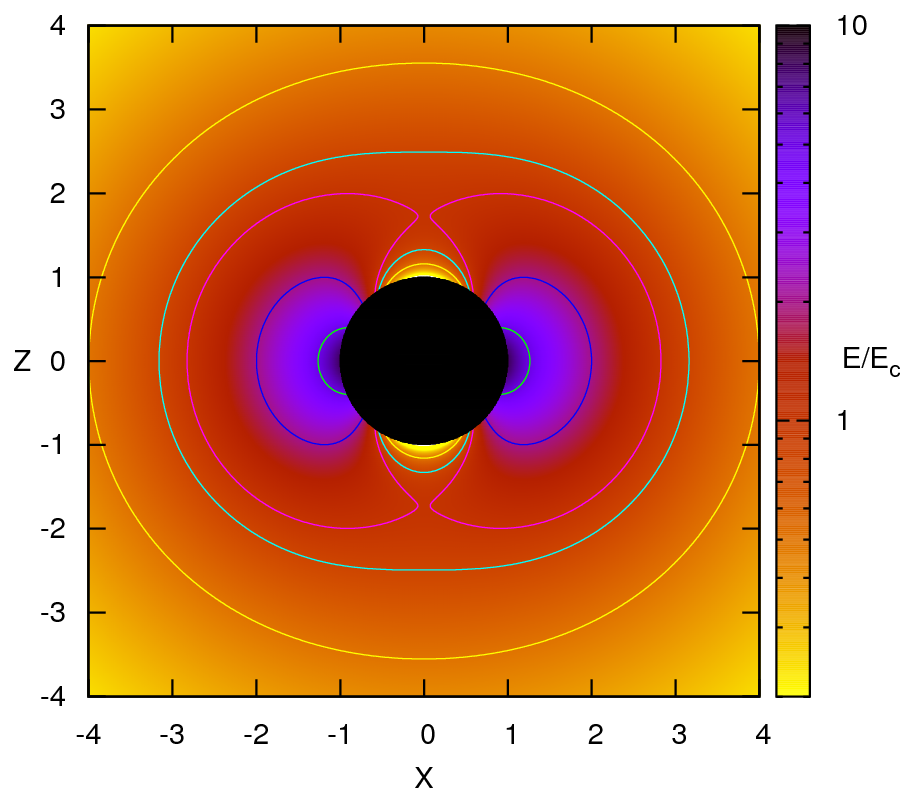
Figure 4
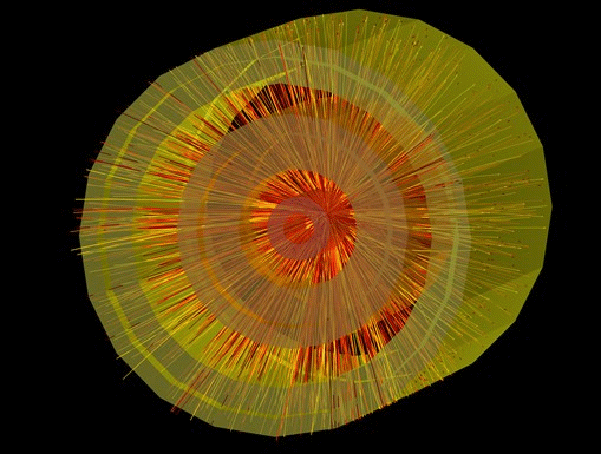
Figure 5
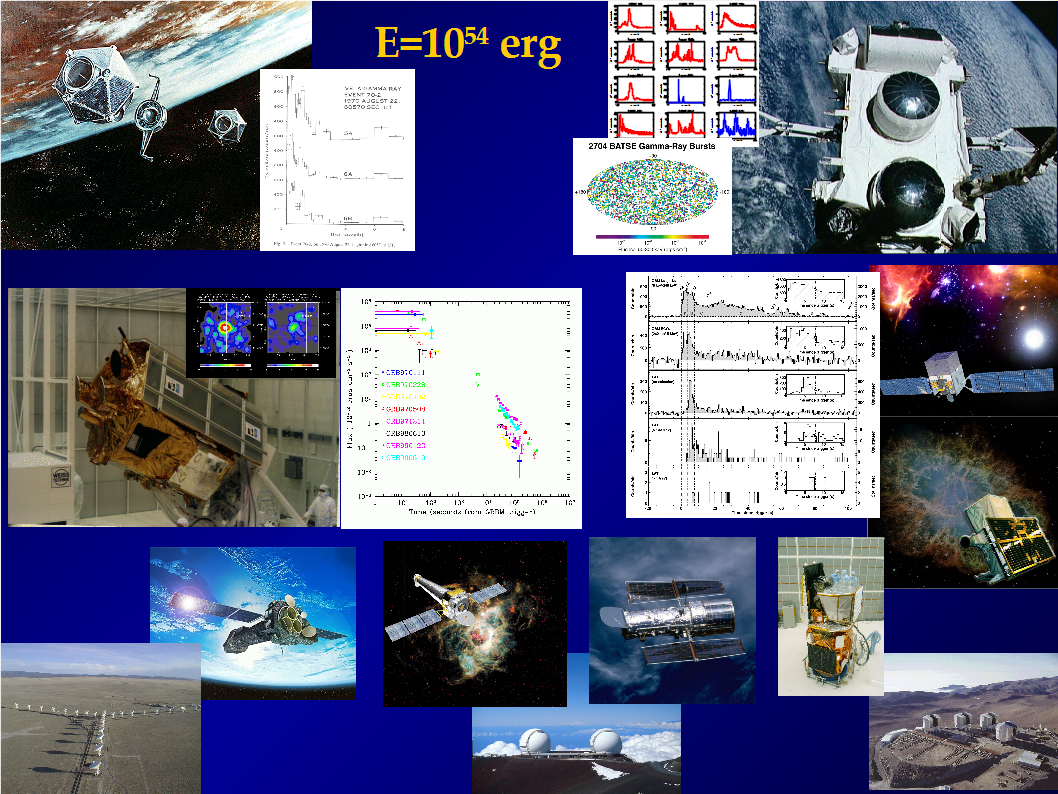
Figure 6
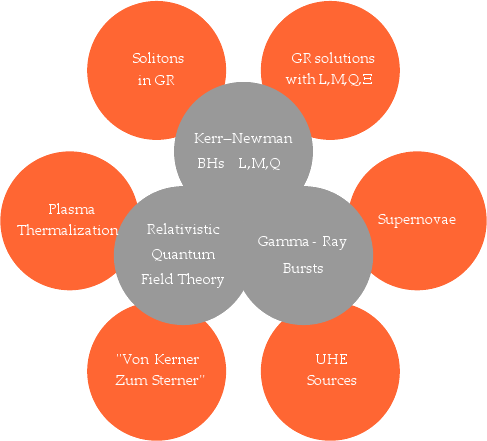
Figure 7
Papers published in 2014 include:
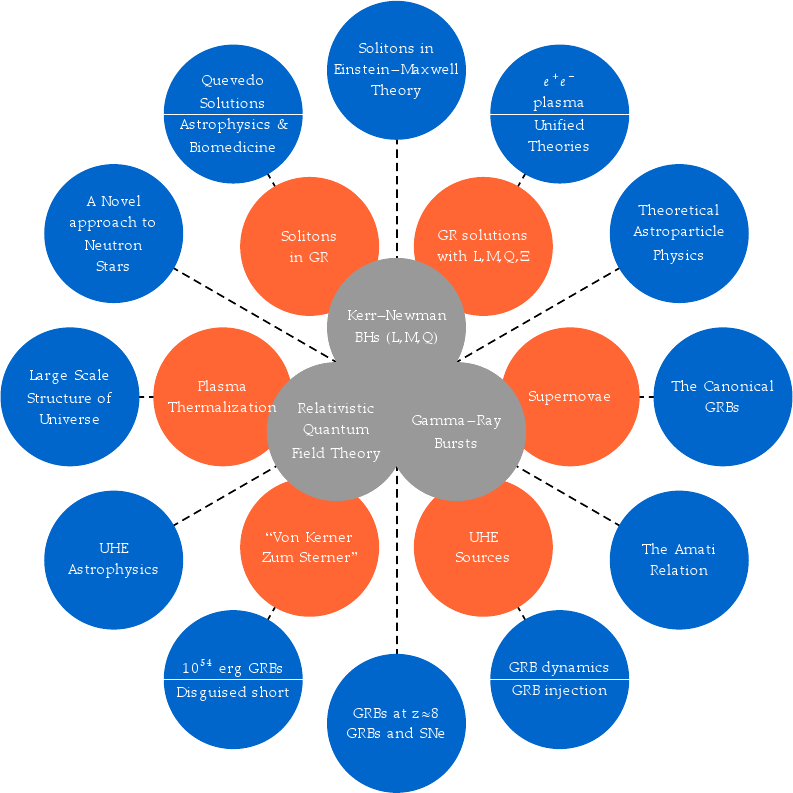
Figure 8
-
Gabici, S. and Aharonian, F. "Hadronic gamma-rays from RX J1713.7-3946?", Monthly Notices of the Royal Astronomical Society: Letters, Volume 445, Issue 1, L70, 2014.
-
Yang, Rui-zhi, Aharonian, F. and Crocker, R. "The Fermi bubbles revisited", Astronomy & Astrophysics, Volume 567, id. A19, 2014.
-
Yang, Rui-zhi, de Ona Wilhelmi, E. and Aharonian, F. "Probing cosmic rays in nearby giant molecular clouds with the Fermi Large Area Telescope", Astronomy & Astrophysics, Volume 566, id. A142, 2014.
-
Kelner, S., Lefa, E., Rieger, F. and Aharonian, F. "The Beaming Pattern of External Compton Emission from Relativistic Outflows: The Case of Anisotropic Distribution of Electrons", The Astrophysical Journal, Volume 785, Issue 2, id. 141, 2014.
-
Zirakashvili, V., Aharonian, F., Yang, R., Ona-Wilhelmi, E. and Tuffs, R. "Nonthermal Radiation of Young Supernova Remnants: The Case of CAS A", The Astrophysical Journal, Volume 785, Issue 2, id. 130, 2014.
-
Khangulyan, D., Aharonian, F. and Kelner, S. "Simple Analytical Approximations for Treatment of Inverse Compton Scattering of Relativistic Electrons in the Blackbody Radiation Field", The Astrophysical Journal, Volume 783, Issue 2, id. 100, 2014.
-
Sahakyan, N., Piano, G. and Tavani, M. "Hadronic Gamma-Ray and Neutrino Emission from Cygnus X-3", The Astrophysical Journal, Volume 780, Issue 1, article id. 29, 2014.
-
Sahakyan, N., Rieger, F., Aharonian, F., Yang, R., and de Ona-Wilhelmi, E. "On the gamma-ray emission from the core and radio lobes of the radio galaxy Centaurus A", International Journal of Modern Physics: Conference Series, Volume 28, id. 1460182, 2014.
-
Sahakyan, N. "Galactic sources of high energy neutrinos", EPJ Web of Conferences, RICAP-14 proceedings, 2014.
-
Sahakyan, N., Zargaryan, D. and Baghmanyan, V. "On the gamma-ray emission from 3C 120", submitted to Astronomy and Astrophysics, 2014.
Exact solutions of Einstein and Einstein-Maxwell equations (Page 53)
The topic of BKL cosmology is one of the most important and classical contributions of Einstein theory to the study of cosmology, fostered at ICRANet-Pescara by Prof. V. Belinski. This classic work, developed by Belinski, Kalatnikov and Lifshitz, has already been reviewed in all the major treaties on general relativity, but only recently a new insight has come from the impressive discoveries made by Thibault Damour at the IHES in Paris, by Prof. Mark Henneaux at the University of Bruxelles, and by Herman Nicolai at the Albert Einstein Institute in Potsdam, on the way to generalize the BKL theory of cosmological singularity to the string theories. The new results can be of essential importance for understanding the problem of cosmological singularity and of the physics around a black hole, as well as for the identification of hidden internal symmetries in fundamental physics. Prof. Belinski has already finished his part of a new book on “Cosmological singularities” which will be written in co-authorship with Prof. Damour. The book has planned to be published by Cambridge University Press. A shortened and adapted version of this book has already been presented in the AIP conference proceedings of XIV Brazilian School of Cosmology and Gravitation (V. Belinski “On the Singularity Phenomenon in Cosmology”, in: Chapter 2, Cosmology and Gravitation: XIV Brazilian School of Cosmology and Gravitation, Cambridge Scientific Publishers, 2011). Three graduate students of the IRAP PhD program are actually working on this topic for their theses with Profs. Hagen Kleinert and Hermann Nicolai in Berlin. Among the completely new results achieved during the last year, first it should be mentioned the exact description of the quantum dynamics of a supersymmetric version of the Bianchi IX cosmological model and identification the basic role of the Kac-Moody algebra in the structure of the quantum Hamiltonian (T. Damour et al.). The second result is the proof of the existence of the general cosmological solution with the Friedman initial singularity if the influence of the dissipative processis near singularity will be taken into account in the framework of the Israel-Stewart theory (V. Belinski).
On a different topic, namely the solitonic equations of GR, an alternative derivation of the Kerr solution had been advanced in a classical paper of 1978 by V. Belinski and V. Zakharov using inverse scattering method. The generalization of this method to the presence of electromagnetic field was constructed in 1980 by G. Alekseev and Kerr-Newman solution has been derived by him in analogous way at the same year. Prof. V. Belinski is now an ICRANet Faculty Member and has further developed this research with the effective collaboration of Prof. G. Alekseev which is an ICRANet Lecturer. During the last years the solitonic solutions of GR has received new interest in respect of the exact solutions of Einstein and Einstein-Maxwell equations: a) The old problem how to generate the exact stationary axisymmetric solutions corresponding to the charged masses with horizons in the framework of Inverse Scattering Method (ISM) was investigated. It was shown that applicability of the ISM in presence of electromagnetic field is not restricted only to the cases with naked singularities (as it has been erroneously stated by some authors). In fact solutions of Einstein-Maxwell equations with horizon also follows from ISM and they are of the same solitonic character. The mathematical procedure of analytical continuations of the naked-singularity solitonic solutions in the space of their parameters which procedure results in solitonic solutions with horizon has been described (G. Alekseev and V. Belinski “Soliton Nature of Equilibrium State of Two Charged Masses in General Relativity”, arXiv:gr-qc/1103.0582, IJMP(D) in press, 2011); b) It was found the new way of derivation of the Kerr solution by adding to the Schwarzchild black hole the solitonic vortex made from the pure gravitational field. With this method, one can figure out how rotational energy can contribute to the mass of the resulting Kerr black hole. Also the relation of the Hanson-Regge type between the mass and angular momentum of a Kerr black hole has been established and its connection with the Christodoulou-Ruffini concept of irreducible mass was analyzed (V. Belinski and H. W. Lee “Kerr rotation as solitonic whirl around Schwarzschild black hole”, Nuovo Cimento, submitted, 2011). During the last year all these constructions was generalized also for the electrically charged black holes. It was shown how one can derive the Kerr-Newman solution by adding a solitonic vortex to the Reissner-Nordstrom black hole.
Papers published in 2014 include:
-
G.A. Alekseev “Travelling waves in the expanding spatially homogeneous space-times”, arXiv:14113023 [gr-qc].
-
G.A. Alekseev “On the Monodromy Transform Approach to Solution of String Gravity and Supergravity Equations in Four and Higher Dimensions”, MG13 Proceedings, Part C, p.1834-1836 (2014).
-
V. Belinski "On the cosmological singularity", IJMPD, 23, 1430016 (2014).
-
V.Belinski "The generic solution with isotropic Big Bang", Astronomy Reports (Springer), in press (2014).
-
L. Orlando and H. Quevedo "Cosmographic study of the universe's specific heat: a landscape for cosmology?", GRG, 46, 1649 (2014).
-
L. Orlando and H. Quevedo "A unified dark energy model from a vanishing speed of sound with emergent cosmological constant", IJMPD, 23, 1450012 (2014).
-
H. Quevedo and M. Quevedo "Cosmological applications of geometrothermodynamics", Gravitation and Cosmology, 20, 208 (2014).
-
T. Damour and A. Nagar "A new analytic representation of the ringdown waveform of coalescing spinning black hole binaries", to appear in Phys. Rev. D, arXiv:1406.0401 [gr-qc].
-
D. Bini and T. Damour "Two-body gravitational spin-orbit interaction at linear order in the mass ratio", Phys. Rev. D 90, 024039 (2014), arXiv:1404.2747 [gr-qc].
-
T. Damour, F. Guercilena, I. Hinder, S. Hopper, A. Nagar and L. Rezzolla "Strong-Field Scattering of Two Black Holes: Numerics Versus Analytics", PRDR, 89, 081503 (2014), arXiv:1402.7307 [gr-qc].
-
T. Damour, P. Jaranowski and G. Sch\"{a}fer "Nonlocal-in-time action for the fourth post-Newtonian conservative dynamics of two-body systems", Phys. Rev. D 89, 064058 (2014), arXiv:1401.4548 [gr-qc].
-
H. Quevedo and S. Toktarbay "A stationary q-metric", Gravitation and Cosmology, 20, 252 (2014).
-
A.M. Alcalde, H. Quevedo and N.F. Svaiter "Single-Bubble Sonoluminescence as Dicke Superradiance at Finite Temperature", Physics of Statistical Mechanics and its Application, 416, 142 (2014).
-
H. Quevedo and D. Tapias "Geometric description of chemical reactions", Journal of Mathematical Chemistry, 52, 141 (2014).
-
A. Bravetti, C.S. Lopez-Monsalvo, F. Nettel and H. Quevedo "Representation invariant Geometrothermodynamics: Applications to ordinary thermodynamic systems", Journal of Geometry and Physics, 81, 1 (2014).
-
O. Luongo and H. Quevedo "Characterizing repulsive gravity with curvature eigenvalues", Phys. Rev. D, 90, 084032 (2014).
-
E. Bittencourt, S. Faci and M. Novello "Chiral symmetry breaking as a geometrical process", IJMP, 29, 1450145, arXiv:1406.2014 [hep-th].
-
E. Bittencourt, V. A. De Lorenci, R. Klippert, M. Novello and J. M. Salim "Analogue black holes for light rays in static dielectrics", CQG, 31, 145007, arXiv:1401.7544 [gr-qc].
Gamma-Ray Bursts (Page 75)
The research on GRBs in ICRANet is wide and has been participated by many Members of the Faculty and of the Adjunct Faculty, as well as by many Lecturers, Research Scientists and graduate students. Traditionally, GRBs are divided into two classes, “short” GRBs and “long” GRBs, arranged in a bimodal distribution with a separation around a duration of 2s. In 2001 we proposed that both short and long GRBs are created by the same process of gravitational collapse to a black hole. The energy source is the e + e - plasma created in the process of the black hole formation. The two parameters characterizing the GRB are the total energy Ee± tot of such an e + e - plasma and its baryon loading B defined as B=MBc2/Ee± tot, where MB is the mass of the baryon loading. The e+e- plasma evolves as a self-accelerating optically thick fireshell up to when it become transparent, hence we refer to our theoretical model as the “fireshell model”. We have defined a “canonical GRB” light curve with two sharply different components. The first one is the Proper-GRB (P-GRB), which is emitted when the optically thick fireshell becomes transparent and consequently has a very well defined time scale determined by the transparency condition. The second component is the emission due to the collision between the accelerated baryonic matter and the CircumBurst Medium (CBM). This comprises what is usually called the “afterglow”. The relative energetics of the two components is a function of B. For B < 10-5 the GRB is “P-GRB dominated”, since the P-GRB is energetically dominant over the second component. The contrary is true for B larger than such a critical value. Since 2001 it has been a major point of our theoretical model that the long GRBs are simply identified with the peak of this second component. In the last years the comprehension of the GRB phenomenon has remarkably increased, thanks to the introduction of the IGC paradigm. The long GRBs associated with Supernovae, which were traditionally considered as an overall single event, are now interpreted as a set of four different Episodes, each one characterized by its own spectral, luminosity and time evolution and corresponding to four different astrophysical processes:
-) The “Episode 1” corresponds to the emission from the onset of a Supernova (SN), in a close binary system with a companion neutron star (NS). The initial SN expansion, at non-relativistic velocities, induces a strong matter accretion onto the NS, which reaches the critical mass and then collapses to a black hole (BH). The observed hard X-ray emission is composed of a thermal spectrum plus a power-law component, both evolving in time.
-) The “Episode 2”, corresponding to the observations of the GRB, is related to the collapse of the NS into a BH.
-) The “Episode 3”, in soft X-rays, occurs when the prompt emission from the GRB fades away and it emerges an additional component we discovered in the Swift XRT data. It has been shown that this component, in energetic (E iso > 1052 erg) GRBs-SNe, when referred to the rest-frame of the source, follows a standard behavior of the light curve evolution. This emission encompasses the SN shock break out and the expanding SN ejecta, and gives origin to an authentic “cosmic candle”.
-) The “Episode 4” is represented by the observations of the optical emission of the SN, which has been observed in some IGC sources, with redshift z < 0.9.
Major progresses have been accomplished this years in the following aspects (see Figs. 10-17):
-
In introducing the new concept of “Binary Driven Hypernovae” (BdHNe) as progenitors of GRBs with an associated supernova and in discovering a “nesting” in the late x-ray light curves of BdHN systems.
-
In studying the BdHN scenario up to extreme cosmological distances.
-
In studying the different properties of short GRBs “genuine” vs. “disguised by excess”.
-
In reviewing old BATSE data finding the same characteristic features of BdHN systems.
-
In dividing GRBs in two different families, based on their energetics, thanks to the results of the analysis of GRB 130427A, associated with SN 2013cq, within the BdHN scenario. A novel proposal for differentiating short and long GRBs has been recently advanced.
Papers published in 2014 include:
-
R. Ruffini, M. Muccino, C.L. Bianco, M. Enderli, L. Izzo, M. Kovacevic, A.V. Penacchioni, G.B. Pisani, J.A. Rueda, Y. Wang; ``On Binary Driven Hypernovae and their nested late X-ray emission''; Astronomy & Astrophysics, 565, L10 (2014).
-
R. Ruffini, L. Izzo, M. Muccino, G.B. Pisani, J.A. Rueda, Y. Wang, C. Barbarino, C.L. Bianco, M. Enderli, M. Kovacevic; ``Induced gravitational collapse at extreme cosmological distances: the case of GRB 090423''; Astronomy & Astrophysics, 569, A39 (2014).
-
M. Muccino, C.L. Bianco, L. Izzo, Y. Wang, M. Enderli, M. Kovacevic, G.B. Pisani, A.V. Penacchioni, R. Ruffini; ``The Genuine Short GRB 090227B and the Disguised by Excess GRB 090510''; Gravitation and Cosmology, 20, 197 (2014).
-
M. Muccino, C.L. Bianco, L. Izzo, Y. Wang, M. Enderli, G.B. Pisani, A.V. Penacchioni, R. Ruffini; ``Two short bursts originating from different astrophysical systems: The genuine short GRB 090227B and the disguised short GRB 090510 by excess''; Journal of the Korean Physical Society, 65, 865 (2014).
-
R. Ruffini, J.A. Rueda, C. Barbarino, C. L. Bianco, H. Dereli, M. Enderli, L. Izzo, M. Muccino, A.V. Penacchioni, G.B. Pisani, Y. Wang; ``Induced Gravitational Collapse in the BATSE era: the case of GRB 970828''; Astronomy Reports, in press (2014).
-
R. Ruffini, Y. Wang, M. Kovacevic, C.L. Bianco, M. Enderli, M. Muccino, A.V. Penacchioni, G.B. Pisani, J. Rueda; ``GRB 130427A and SN 2013cq: A Multi-wavelength Analysis of An Induced Gravitational Collapse Event''; The Astrophysical Journal, in press (2014).
-
R. Ruffini; ``Black Holes, Supernovae and Gamma Ray Bursts''; in Proceedings of the Thirteenth Marcel Grossmann Meeting on General Relativity, Stockholm, Sweden, July 2012, R.T. Jantzen, K. Rosquist, R. Ruffini, Editors; World Scientific, (Singapore, 2014).
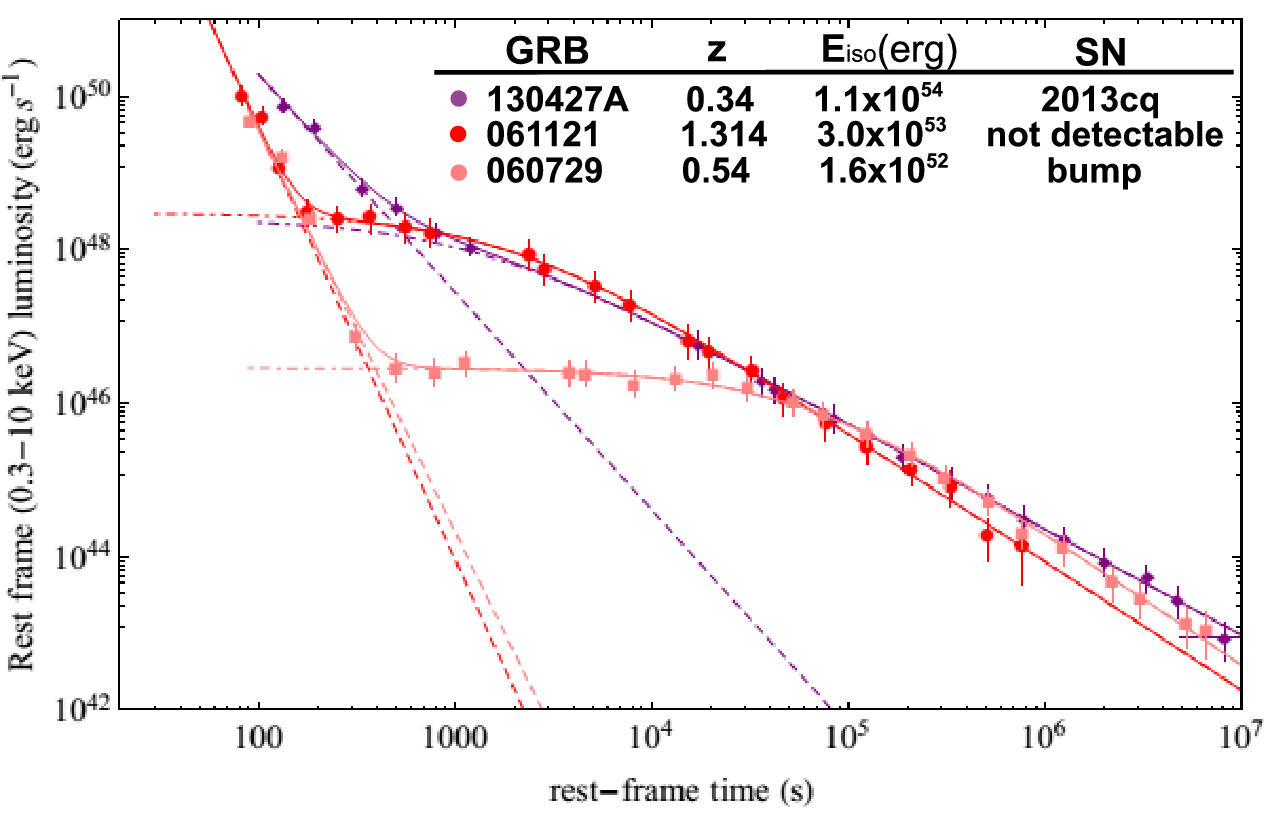
Figure 10: BdHN “nested” late X-ray emission
Reproduced from Ruffini et al., A&A, 565, L10 (2014).
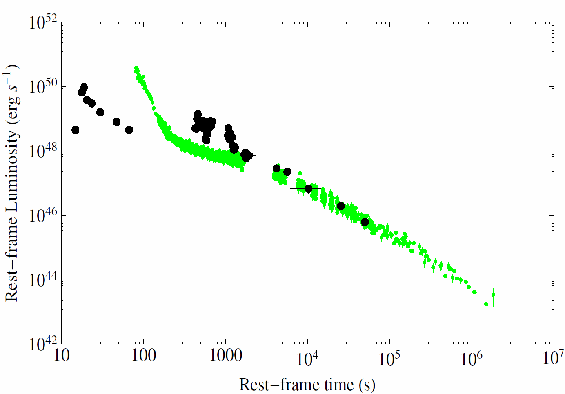
Figure 11: Overlap of GRB 090618 (z=0.54, green) and GRB 090423 (z=8.2, black) x-ray light curves, as implied by the BdHN scenario.
Reproduced from Ruffini et al., A&A, 569, A39 (2014).
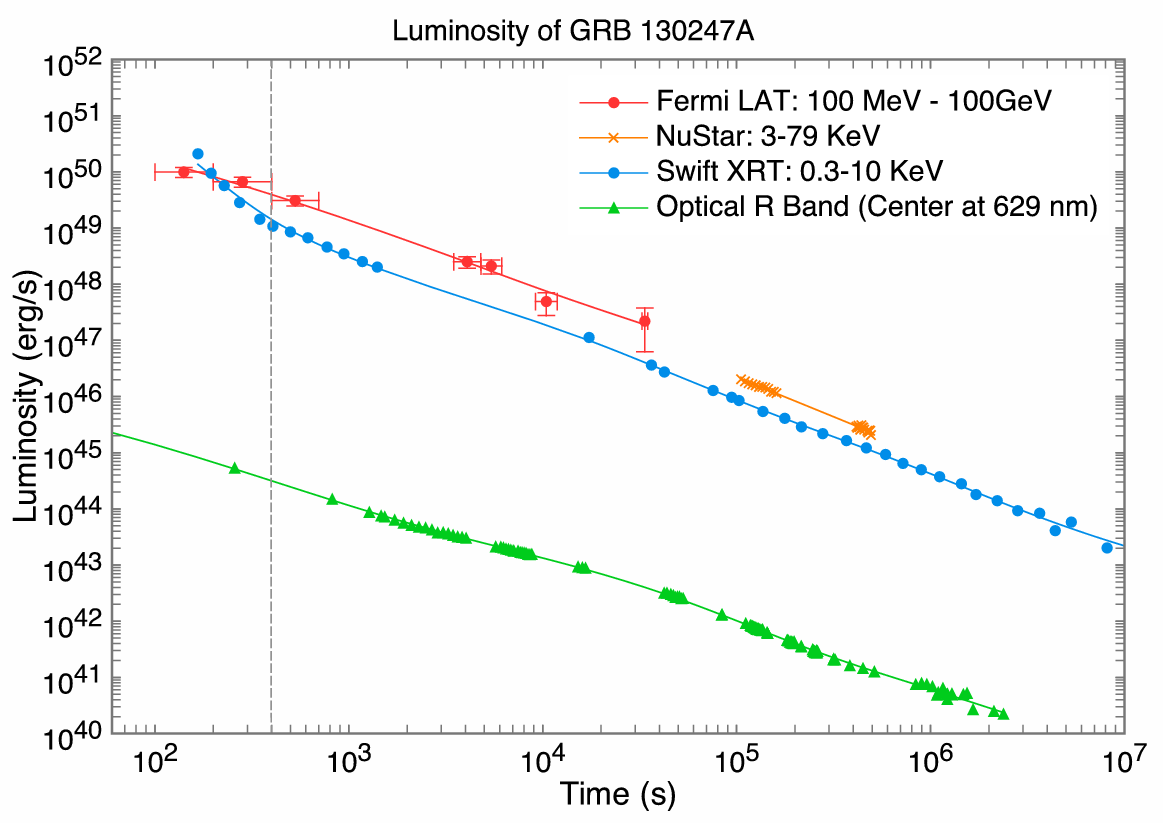
Figure 12: Multiweavelength light curves of GRB 130427A
R eproduced from Ruffini et al. ApJ , in press (2014).
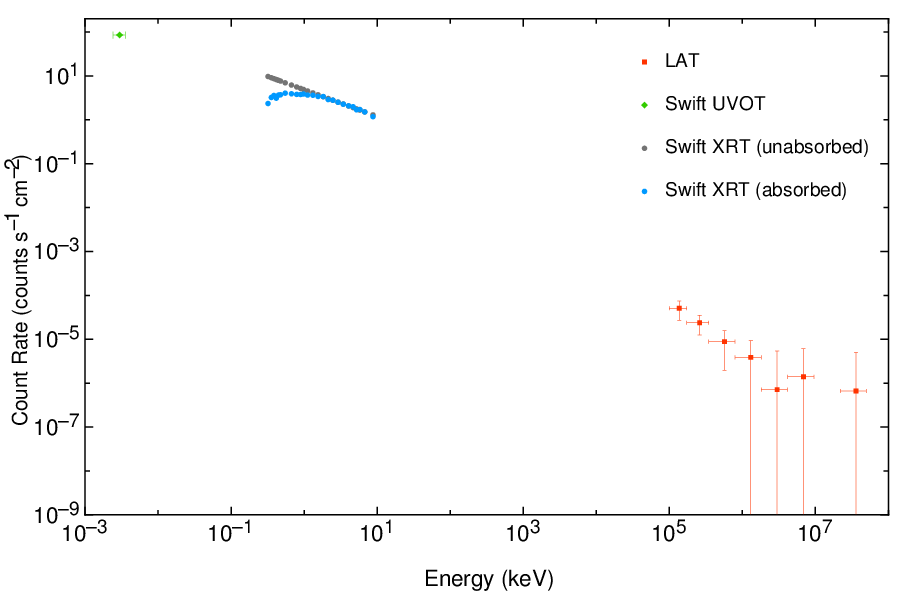
Figure 13: Broadband spectral analysis of GRB 130427A
Reproduced from Ruffini et al. ApJ, in press (2014).
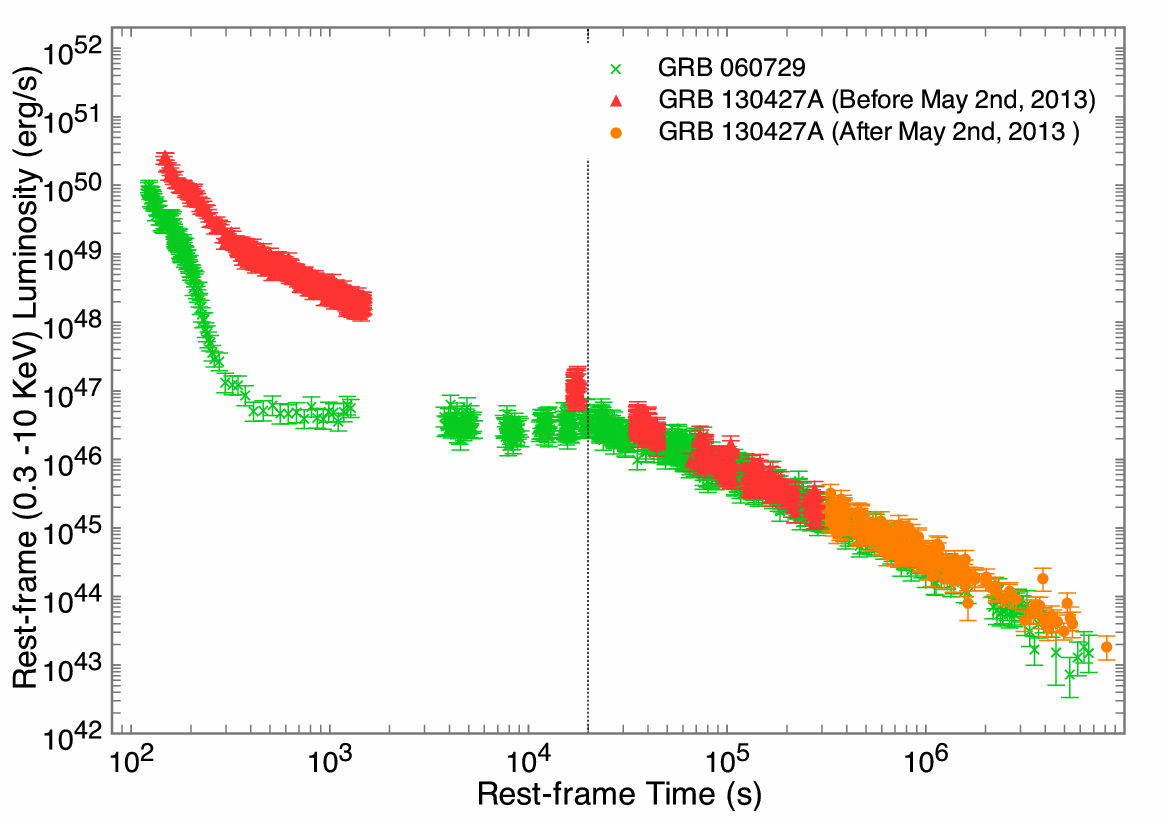
Figure 14: The universal behavior of BdHN lte x-ray light curves confirmed in GRB 130427A .
Reproduced from Ruffini et al. ApJ, in press (2014).
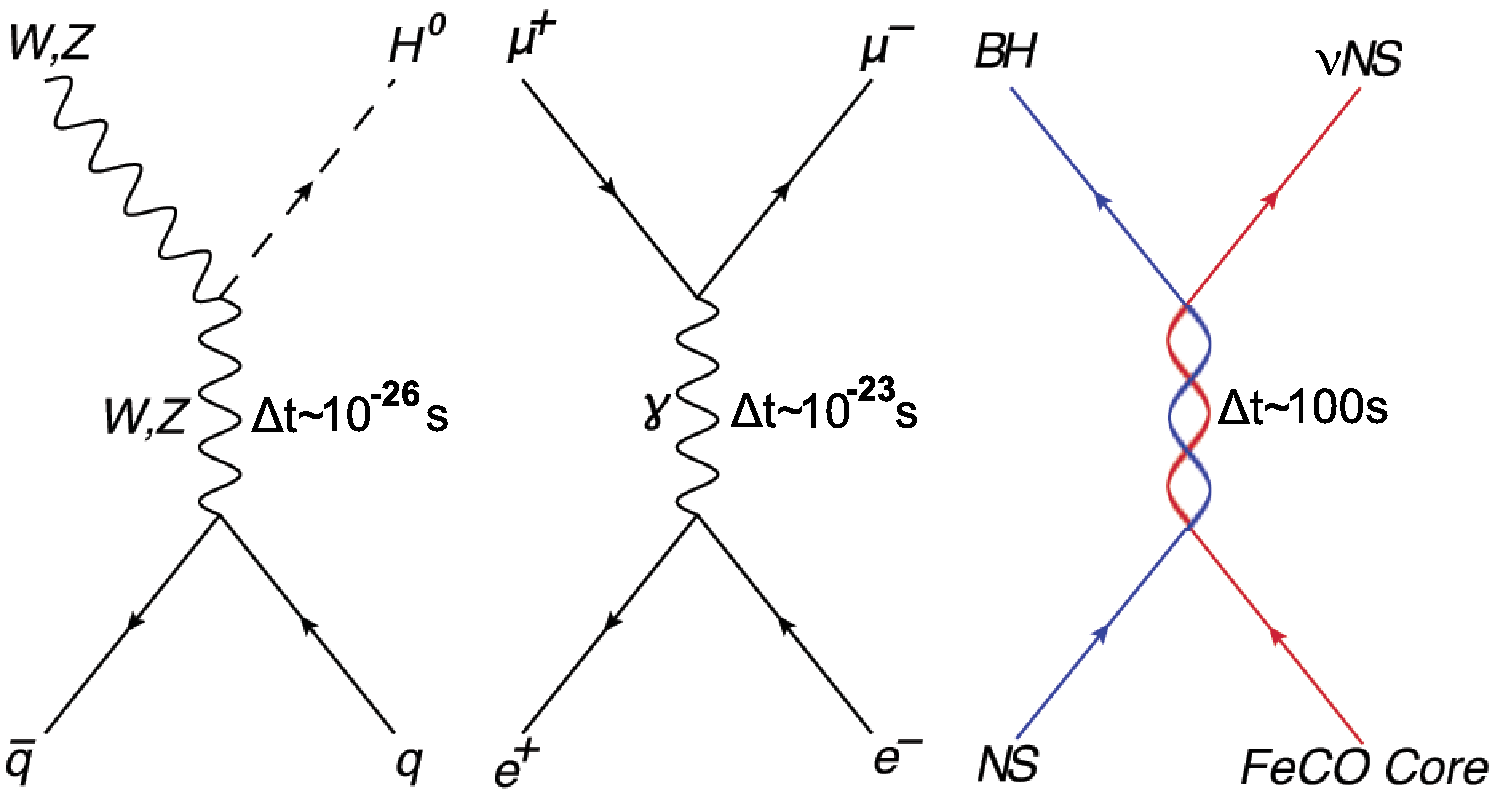
Figure 15: The “ cosmic matrix” of the IGC scenario .
Reproduced from Ruffini et al. ApJ, in press (2014).
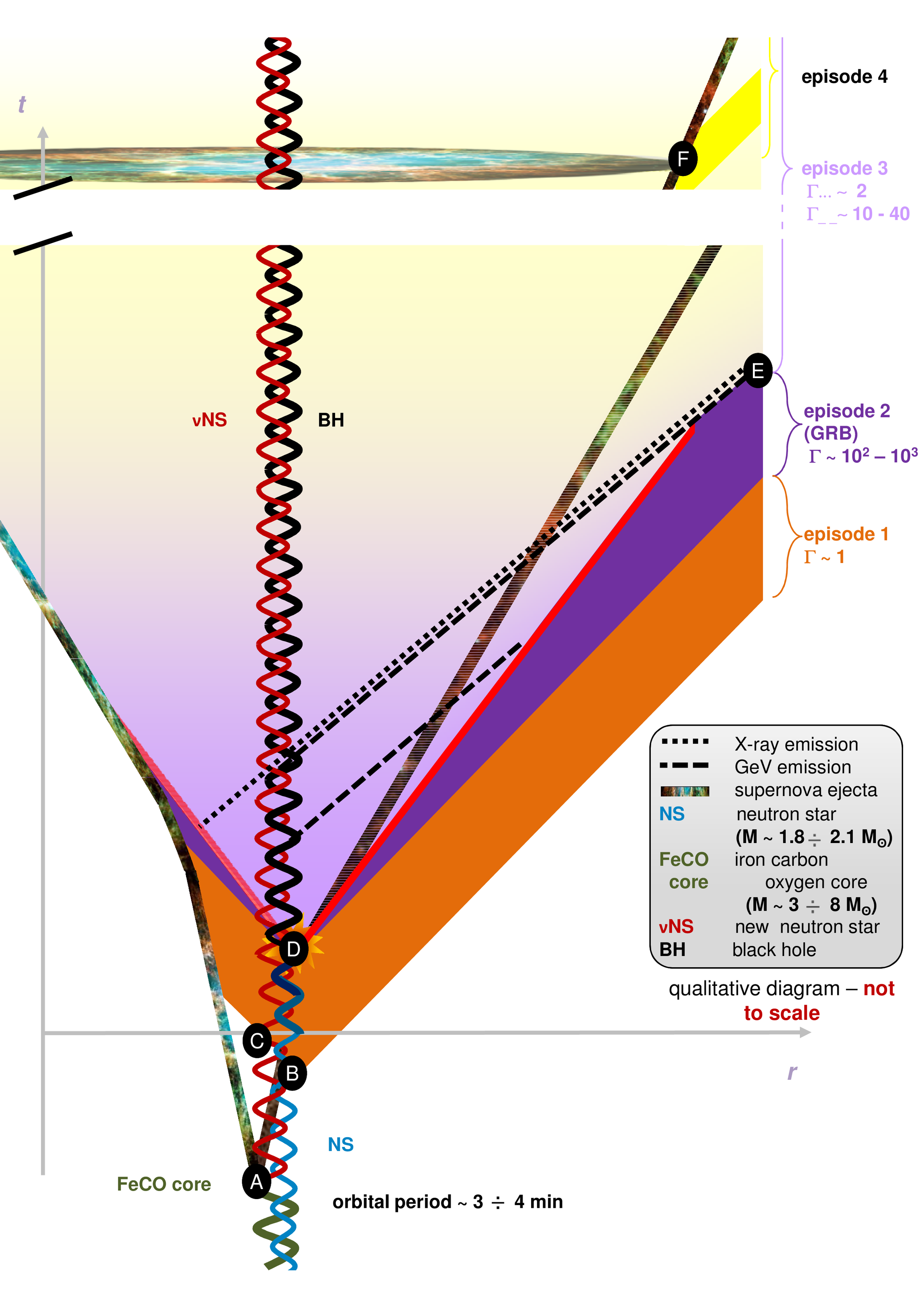
Figure 16: Qualitative space-time diagram of the IGC scenario.
Reproduced from Ruffini et al. ApJ, in press (2014).
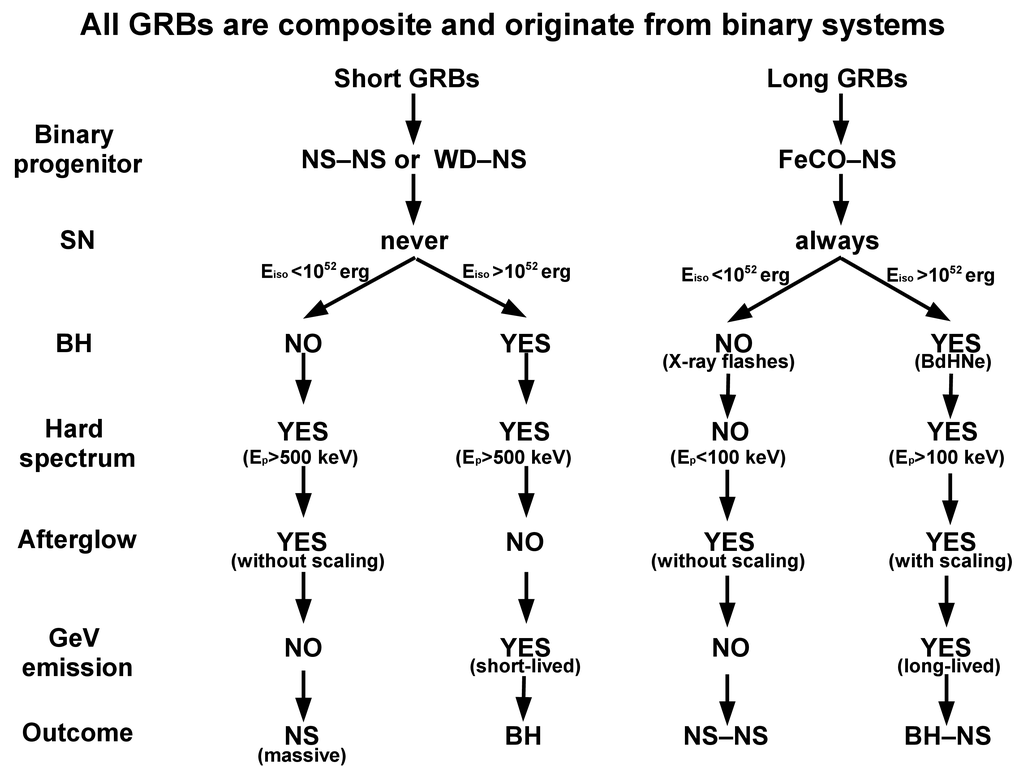
Figure 17: A novel proposal for differentiating short and long GRBs.
Reproduced from Ruffini et al., talk at Swift10 Meeting, December 2nd, 2014.
Relativistic effects in Physics and Astrophysics (Page 209)
In this report it is studied the distribution of the GRB bolometric luminosity over the EQTSs, with special attention to the prompt emission phase. We analyze as well the temporal evolution of the EQTS apparent size in the sky. We use the analytic solutions of the equations of motion of the fireshell and the corresponding analytic expressions of the EQTSs which have been presented in recent works and which are valid for both the fully radiative and the adiabatic dynamics. We find the novel result that at the beginning of the prompt emission the most luminous regions of the EQTSs are the ones closest to the line of sight. On the contrary, in the late prompt emission and in the early afterglow phases the most luminous EQTS regions are the ones closest to the boundary of the visible region (see Fig. 18). We find as well an expression for the apparent radius of the EQTS in the sky, valid in both the fully radiative and the adiabatic regimes. Such considerations are essential for the theoretical interpretation of the prompt emission phase of GRBs.
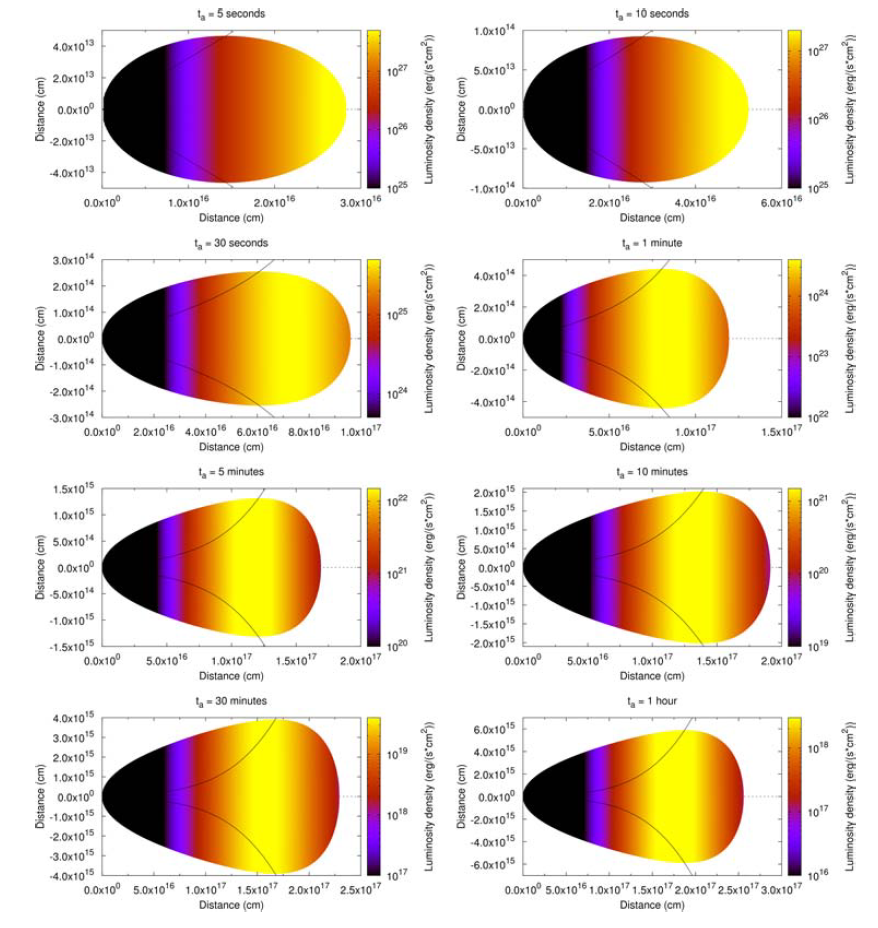
Figure 18: Evolution of luminosity over the EQTSs
Reproduced from Bianco, Massucci, Ruffini, IJMPD, 20, 1919 (2011).
Big data analysis (Page 271)
Particularly interesting, and connected to the above topics, is also the project on big data analysis. The current situation in astrophysics allows to use large archival astrophysical data from infrared, optical and very high energetic radiations. This new situation allows to study a single source in a multi-wavelength context, and permits to obtain more information on the physical mechanisms behind the observed radiation. Recently we have started and developed a program involving the use of already existing software packages for space data reduction, as Swift, Fermi, XMM and HST, and on-ground facilities as optical telescopes at ESO and Canary Island. New collaborations started, about the study of optical transients, as well for the analysis in real-time of high-energy sources as GRBs.
Papers published ni 2014 include:
-
Kovacevic, M.; Izzo, L.; Wang, Y.; Muccino, M.; Della Valle, M.; Amati, L.; Barbarino, C.; Enderli, M.; Pisani, G. B.; Li, L.; “A search for Fermi bursts associated with supernovae and their frequency of occurrence”, (2014) A&A, 569, 108
-
Izzo, L.; Della Valle, M.; Ederoclite, A.; Henze, M.; “On the 2011 outburst of the Recurrent Nova T Pyxidis”, (2014) Acta Politechnica, in press, arXiv:1407.7076
-
Diego, Jose M.; Broadhurst, T.; Benitez, N.; Umetsu, K.; Coe, D.; Sendra, I.; Sereno, M.; Izzo, L.; Covone, G.; “A Free-Form Lensing Grid Solution for A1689 with New Mutiple Images”, (2014), Monthly Notices of the Royal Astronomical Society, in press, arXiv:1402.4170
-
Cao, Shuo; Covone, Giovanni; Jullo, Eric; Richard, Johan; Izzo, Luca; Zhu, Zong-Hong; “Source plane reconstruction of the giant gravitational arc in Abell 2667: a candidate Wolf-Rayet galaxy at z~1”, (2014), The Astronomical Journal, in press, arXiv:1410.6594
Cosmology and Large Scale Structures (Page 285)
This Report, led by Prof. Fang LiZhi, manifests the progress made by the ICRANet group at the University of Arizona. It deals with three different topics. A. Turbulence behavior of cosmic baryon gas. With hydrodynamic simulation sample of the LCDM universe produced by the WENO algorithm, we show that the intermittency of the velocity field of cosmic baryon fluid at redshift z=0 in the scale range from the Jeans length to about 16h -1 Mpc can be extremely well described by the She-Lévĕque's scaling formula, which is used to describe a fully developed turbulence. We also found that the non-Gaussian features of the cosmic baryon fluid and Ly-a transmitted flux of quasar absorption spectrum can be well described by a log-Poisson hierarchy. B. Wouthuysen-Field coupling. With a state-of-the-art numerical method, we show that the resonant scattering of Ly-a photons with neutral hydrogen atoms will lock the color temperature of the photon spectrum around the Ly-a frequency to be equal to the kinetic temperature of hydrogen gas. The time scales of the onset of Wouthuysen-Field coupling, the profile of frequency distribution of photons in the state of local thermal equilibrium, the effects of the expansion of the universe on the Wouthuysen-Field coupling in an optical thick halos have also been found. These results are essential for studying the 21 cm signal from high redshift sources. C. Time-dependent behavior of Ly a photon transfer. Ly a photons have been widely applied to study cosmological problems in high redshifts. Since the time scales of high redshift sources, such as GRBs, generally are short, time-dependent solutions of Ly a photon transfer becomes serious. However, no reliable numerical solvers of the time-dependent problem of radiative transfer equation with resonant scattering have been developed till 2006. The time-dependent solver (Meiksin, MN, 370, (2006), 2025-2037) still cannot pass the test of analytical solutions (Field, ApJ, 129, (1959), 551). The solver based on the WENO scheme has been established. It can very well pass various tests (Roy et al ApJ, 716, 2010, 604). It reveals many interesting features of the time evolution of resonant photons Ly a in optical thick medium. It provides the solutions of studying the time-dependent effect of resonant scattering on the profile of red damping wing of GRBs. It is crucial to understand the halos of GRBs. This report is going to be updated thanks to the new contributions of Prof. XiaoHui Fan.
Theoretical Astroparticle Physics (Page 335)
Th is Report represents the summary of activities during the last year on this topic by the group including: Carlo Luciano Bianco, Remo Ruffini, Gregory Vereshchagin, She- Sheng Xue. Students working within the group include: Damien Begue, Carlos Arguelles, Yu Wang ; post-doc: Ivan Siutsou.
Astroparticle physics is a new field of research emerging at the intersection of particle physics, astrophysics and cosmology. We focused on several topics with three major directions of research: a) electron-positron plasma, b) thermal emission from relativistic plasma and GRBs, c) neutrinos and large scale structure formation in cosmology, d) self-gravitating systems as Dark Matter in galaxies.
Electron-positron plasma appear relevant for GRBs and also for the Early Universe, in laboratory experiments with ultraintense lasers, etc. We study both nonequilibrium effects such as thermalization and associated timescales, as well as dynamical effects such as accelerated expansion in the optically thick regime. Relativistic numerical codes are designed and widely implemented in this research. The basic outcomes include: determination from the first principles of relaxation timescales of optically thick electron-positron plasma with baryonic loading in the wide range of plasma parameters; conclusion that deviations from a simple "frozen radial profile" in spatial distributions of energy and matter densities of expanding electron-positron plasma with baryonic loading are possible. The last conclusion imply in particular the possibility to recover the spatial distribution of matter and energy in the process of collapse of a GRB progenitor to a black hole. We examine quantum corrections to the collision integrals and determine timescales of relaxation towards thermal equilibrium for high temperature electron-positron-photon plasma. (A.G. Aksenov, R. Ruffini. I.A. Siutsou and G.V. Vereshchagin, “Bose enhancement and Pauli blocking in the pair plasma”, in preparation). Oral report on this topic will be made by I.A. Siutsou.
We study the thermal emission from relativistic plasma and GRBs , which is relevant for understanding GRB emission when plasma in relativistic produces photospheric emission. In particular, we focused on several topics including: transparency of an instantaneously created electron-positron-photon plasma (D. Begue and G.V. Vereshchagin, MNRAS, Vol. 439 (2014) 924); thermal emission in early afterglow from the GRB-SNR interaction (R. Ruffini G. V. Vereshchagin Yu Wang, in preparation), and the traditional topic of photospheric emission in ultrarelativistic outflows (G.V. Vereshchagin, IJMPD 23 (2014) 1430003, and I.A. Siutsou, R. Ruffini and G.V. Vereshchagin, New Astronomy 27 (2014) 30). We also discovered an interesting effect of relativistic spotlight (I.A. Siutsou and G.V. Vereshchagin, PLB 730 (2014) 190). The oral report on this topic will be made by G.V. Vereshchagin.
In the framework of cosmology we show how the distribution of Dark Matter (DM) in galaxies can be explained within a model based on a semidegenerate self-gravitating system of fermions in General Relativity. The oral report on this topic will be made by C. Arguelles (see Figs. 19-23) .
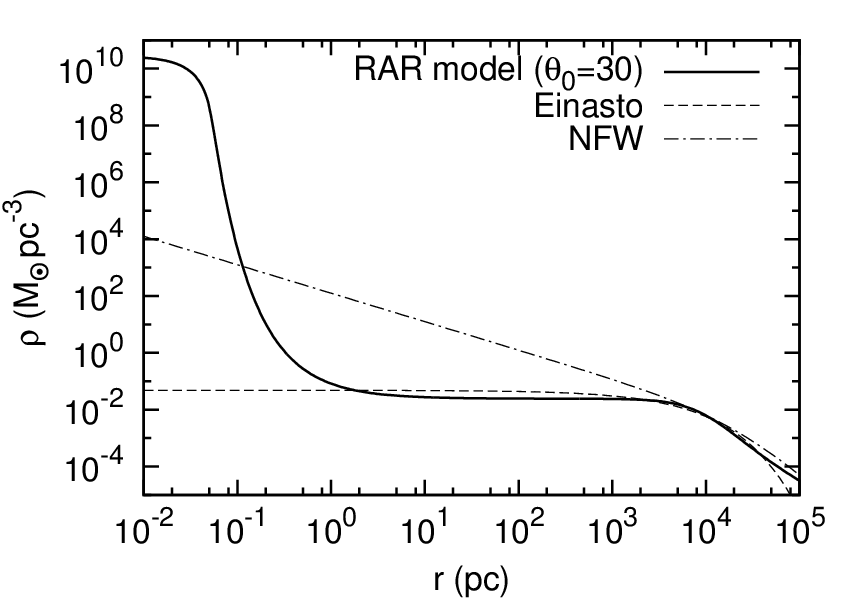
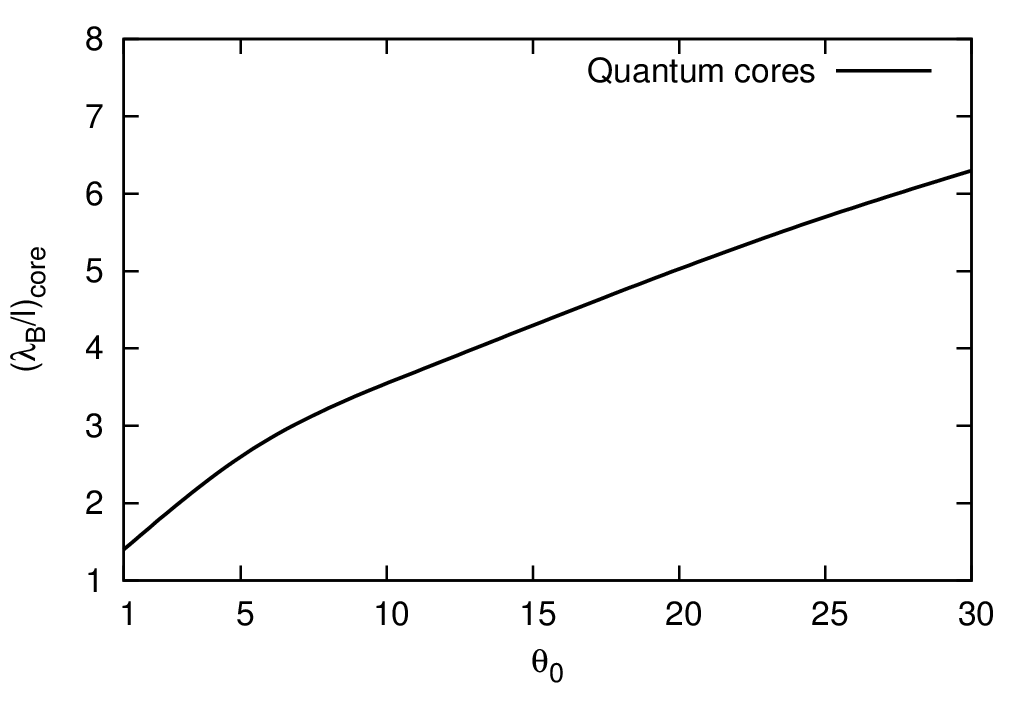
Figure 19: Cored behavior of the dark matter density profile from the Ruffini-Arguelles-Rueda (RAR) model is contrasted with the cuspy Navarro-Frenk-White (NFW) density profile, and with a cored-like Einasto profile.
Figure 20: The less degenerate quantum cores in agreement with the adopted halo observables. These cores are the ones which achieve the largest sizes, of order # kpc, and implying the lowest ino masses in the sub-keV region.
Reproduced from Ruffini, Arguelles, Rueda, arXiv:1409.7365
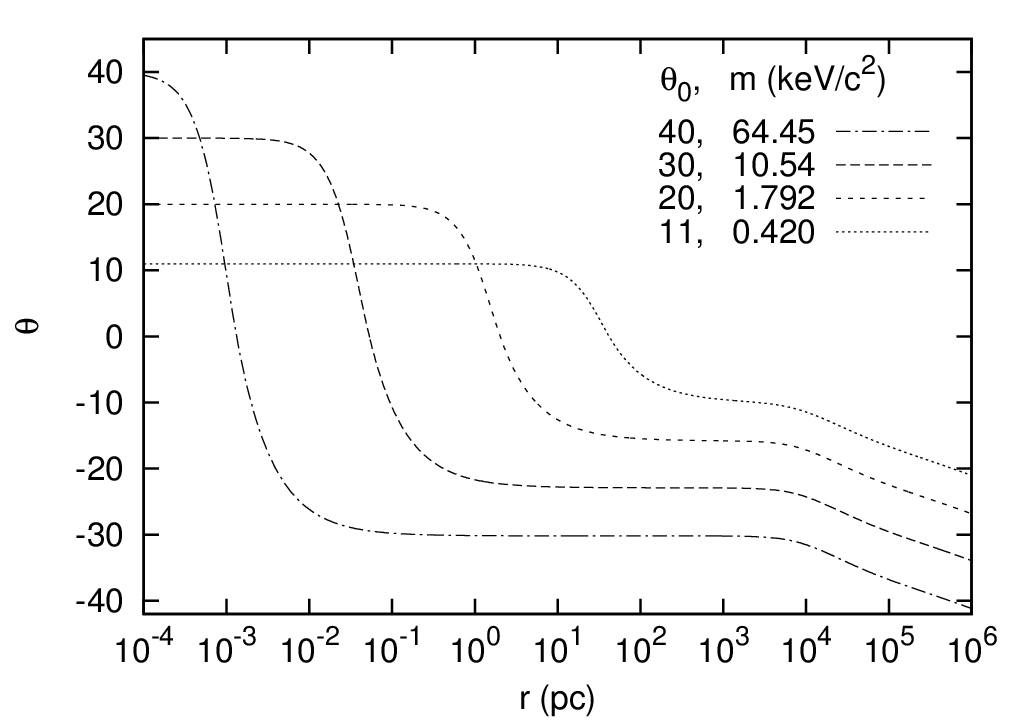
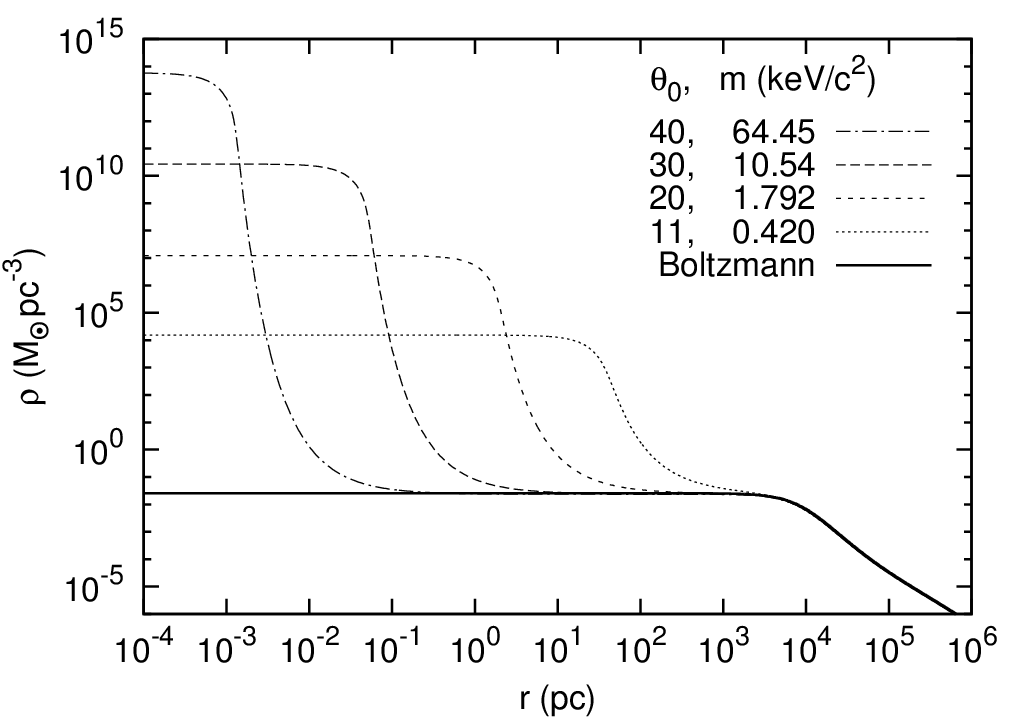
Figure 21: Degeneracy parameter profile for specific ino masses and central degeneracies fulfilling the observational halo constraints.
Figure 22: Mass density profile for specific ino masses and central degeneracies fulfilling the observational halo constraints, compared with a Boltzmannian isothermal sphere.
Reproduced from Ruffini, Arguelles, Rueda, arXiv:1409.7365
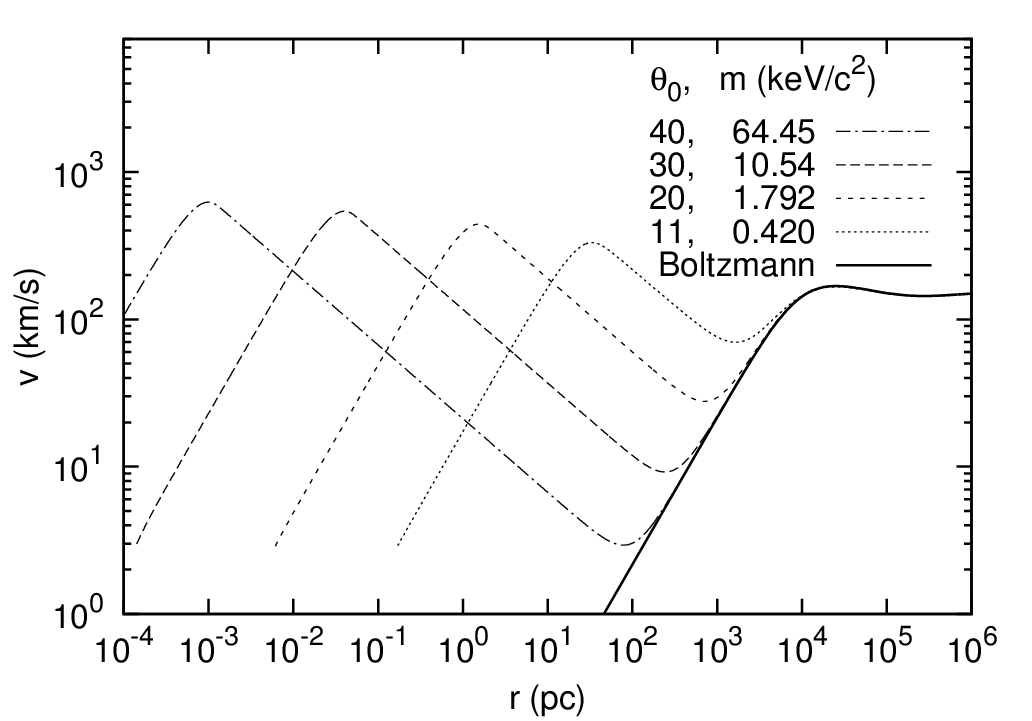
Figure 23: Rotation velocity curves for specific ino masses and central degeneracies fulfilling the observational halo constraints. Reproduced from Ruffini, Arguelles, Rueda, arXiv:1409.7365
Papers published in 2014 include:
-
D. Begue and G.V. Vereshchagin, “Transparency of an instantaneously created electron-positron-photon plasma”, MNRAS, Vol. 439 (2014), pp. 924-928.
-
I.A. Siutsou and G.V. Vereshchagin, “Relativistic spotlight”, Physics Letters B, Volume 730 (2014), pp. 190–192.
-
G.V. Vereshchagin, “Physics of non-dissipative ultrarelativistic photospheres”, International Journal of Modern Physics D Vol. 23, No. 1 (2014) 1430003.
-
I.A. Siutsou, R. Ruffini and G.V. Vereshchagin, “Spreading of ultrarelativistically expanding shell: an application to GRBs”, New Astronomy, Vol. 27 (2014), pp. 30-33.
-
A. G. Aksenov, R. Ruffini, and G. V. Vereshchagin, “Radiative transfer in relativistic plasma outflows and comptonization of photons near the photosphere”, Astronomy Reports, 2014, in press.
-
C. R. Arguelles, R. Ruffini, I. Siutsou, and B. Fraga, “On the distribution of dark matter in galaxies: quantum treatments”, JKPS 65: 801, 2014.
-
C. R. Arguelles, B. Fraga, and R. Ruffini, “Critical configurations for a system of semidegenerate fermions”, JKPS 65: 809, arXiv:astro-ph/1402.1329, 2014.
-
C. R. Arguelles and R. Ruffini, “Are the most super-massive dark compact objects harbored at the center of dark matter halos?”, Honorable mention by the Gravity Research Foundation 2014, IJMPD 23 No. 12, 1442020, arXiv:astro-ph/1405.7505, 2014.
-
C. R. Arguelles and R. Ruffini, “A regular and relativistic Einstein cluster within the S2 orbit centered in SgrA*”, IJMPD in press, 2014.
Generalization of the Kerr-Newman solution (Page 657)
The unsolved problem of a physical solution in general relativity of an astrophysical object which must be characterized necessarily by four parameters, mass, charge, angular momentum and quadrupole moment, has also been debated for years and it is yet not satisfactorily solved. The presence in ICRANet of Prof. Quevedo as an Adjunct Professor has shown an important result published by Bini, Geralico, Longo, Quevedo [Class. Quant. Grav., 26 (2009), 225006]. This result has been obtained for the special case of a Mashhoon-Quevedo solution characterized only by mass, angular momentum and quadrupole moment. It has been shown that indeed such a Mashhoon-Quevedo solution can be matched to an internal solution solved in the post-Newtonian approximation by Hartle and Thorne for a rotating star.
The most important metrics in general relativity is the Kerr-Newman solution which describes the gravitational and electromagnetic fields of a rotating charged mass, characterized by its mass M, charge Q and angular momentum L in geometrical units. This solution characterizes the field of a black hole. For astrophysical purposes, however, it is necessary to take into account the effects due to the moment of inertia of the object. To attack this problem, an exact solution of the Einstein-Maxwell equations have been proposed by Mashhoon and Quevedo which posses an infinite set of gravitational and electromagnetic multipole moments. It is not clear, however, how this external solution to an astrophysical object can be matched to a physical internal solution corresponding to a physically acceptable rotating mass. Are here reported current progresses in using an explicit solution of the Hartle-Thorne equation to an eternal solution with N independent quadrupole moments. Equally important has been the result recently obtained by Belvedere showing that a fast rotating model of neutron star with global charge neutrality within the Hartle-Thorne approximation leads to an internal solution of the Kerr metric.
Papers published in 2014 include:
-
Hernando Quevedo, Diego Tapias JOURNAL OF MATHEMATICAL CHEMISTRY Volume 52, 141-161.
-
Orlando Luongo, Hernando Quevedo GENERAL RELATIVITY AND GRAVITATION Volume: 46 Issue: 1 Article Number: 1649.
-
Orlando Luongo, Hernando Quevedo INTERNATIONAL JOURNAL OF MODERN PHYSICS D Volume: 23 Issue: 2 Article Number: 1450012
-
Alessandro Bravetti, Cesar S. Lopez-Monsalvo, Francisco Nettel, Hernando Quevedo JOURNAL OF GEOMETRY AND PHYSICS Volume: 81 Pages: 1-9
-
Hernando Quevedo, Maria N. Quevedo GRAVITATION & COSMOLOGY Volume: 20 Issue: 3 Pages: 208-213
-
Hernando Quevedo, Maria N. Quevedo, Alberto Sanchez, Safia Taj PHYSICA SCRIPTA Volume 89, 084007
-
M. Aparicio Alcalde, Hernando Quevedo, Nami F. Svaiter PHYSICA A: STATISTICAL MECHANICS AND ITS APPLICATIONS Volume: 416 Pages: 142-148
-
Hernando Quevedo, Saken Toktarbay GRAVITATION AND COSMOLOGY Volume: 20 Issue: 4 pages: 252–254
-
Orlando Luongo, Hernando Quevedo PHYSICAL REVIEW D Volume: 90, 084032.
Scientific Activity of the Ferrara High Energy Astrophysics Group (Page 815)
The main research activities of the Astrophysics group at University of Ferrara include: Experimental activities for the development of technologies for future high-energy missions; Observational and theoretical studies of high-energy phenomena, such as compact objects in binary systems and Gamma-ray Bursts (GRBs); Observational activities in extra-galactic astronomy and Cosmology.
Papers published in 2014 include:
-
van Putten, Maurice H. P. M.; Guidorzi, Cristiano; Frontera, Filippo, Broadband Turbulent Spectra in Gamma-Ray Burst Light Curves, The Astrophysical Journal, Volume 786, Issue 2, article id. 146, 8 pp. (2014).
-
Amati, Lorenzo; Campana, Riccardo; Evangelista, Yuri; Feroci, Marco; Fuschino, Fabio; Labanti, Claudio; Salvaterra, Ruben; Stratta, Giulia; Tagliaferri, Gianpiero; Frontera, Filippo; Guidorzi, Cristiano; Rosati, Piero; Titarchuk, Lev; Braga, Joo; Penacchioni, Ana; Ruffini, Remo; Izzo, Luca; Zampa, Nicola; Vacchi, Andrea; Santangelo, Andrea; Hudec, Rene; Gomboc, Andreja; Rodic, Tomaz, GAME: GRB and All-sky Monitor Experiment, International Journal of Modern Physics D, Volume 23, Issue 6, id. 1430010 (2014).
-
Campana, Riccardo; Orlandini, Mauro; Del Monte, Ettore; Feroci, Marco; Frontera, Filippo, The radiation environment in a low earth orbit: the case of BeppoSAX, Experimental Astronomy, Volume 37, Is- sue 3, pp.599-613 (2014)
-
Dichiara, S.; Guidorzi, C.; Amati, L.; Frontera, F., VizieR Online Data Catalog: BeppoSAX/GRBM and Fermi/GBM long GRBs, VizieR On-line Data Catalog: J/MNRAS/431/3608. Originally published in: 2013MNRAS.431.3608D (2014)
-
R. Bouwens et al. (37 coauthors including P. Rosati) A Census of Star-forming Galaxies in the Z ~ 9-10 Universe based on HST+Spitzer Observations over 19 Clash Clusters: Three Candidate Z ~ 9-10 Galaxies and Improved Constraints on the Star Formation Rate Density at z ~ 9.2 (2014), ApJ, 795, 126 (2014)
-
M. Donahue et al. (38 coauthors including P. Rosati); CLASH-X: A Comparison of Lensing and X-ray Techniques for Measuring the Mass Profiles of Galaxy Clusters, ApJ, 794, 136, (2014) (arXiv1405.7876)
-
K. Umetsu et al. (41 coauthors including P. Rosati); CLASH: Weak-Lensing Shear-and-Magnification Analysis of 20 Galaxy Clusters, ApJ, 795, 163 (2014) (arXiv1404.1376)
-
J. Merten et al. (41 coauthors including P. Rosati) 2014 ; CLASH: The Concentration-Mass Relation of Galaxy Clusters, ApJ, in press (2014) (arXiv1405.7876)
-
M. Meneghetti et al. (45 coauthors including P. Rosati) 2014 ; The MUSIC of CLASH: predictions on the concentration-mass relation, ApJ, in press (2014) (arXiv1404.1384)
-
Annunziatella, M., Biviano, A., Mercurio, A., Nonino, A., Rosati, P. et al. (22 other coauthors) 2014; CLASH-VLT: The stellar mass function and stellar mass density profile of the z = 0.44 cluster of galaxies MACS J1206.2-0847, A&A, in press (2014)
-
R. Fassbender et al. (23 coauthors including P.Rosati); Galaxy population properties of the massive X-ray luminous galaxy cluster XDCP J0044.0- 2033 at z = 1.58: red-sequence formation, massive galaxy assembly, and central star formation activity, A&A, 568, A5 (2014)
-
Tozzi, P., Moretti, A., Tundo, E., Liu, T., Rosati, P. et al. (5 other coauthors) The Swift X-ray Telescope Cluster Survey. II. X-ray spectral analysis, A&A, 567, 89A (2014)
-
Grillo, C., Gobat, R., Presotto, V., Balestra, I., Mercurio, A,, Rosati, P. et al. (32 other coauthors), CLASH: Extending Galaxy Strong Lensing to Small Physical Scales with Distant Sources Highly Magnified by Galaxy Cluster Members, ApJ, 786, 11 (2014)
-
P. Brandon et al. (45 coauthors including P. Rosati); Three Gravitationally Lensed Supernovae behind CLASH Galaxy Clusters, ApJ, 786, 9 (2014)
-
Presotto, V., Girardi, M., Nonino, M., Mercurio, A., Grillo, C., Rosati, P. et al. (33 other coauthors); Intracluster light properties in the CLASH-VLT cluster MACS J1206.2-0847, A&A, 565, 126A (2014)
-
De Grandi, S., Santos, J.S., Nonino, M., Molendi, S., Tozzi, P., Rossetti, M., Fritz, A., Rosati, P. ; On the Fe abundance peak formation in cool-core clusters of galaxies: hints from cluster WARPJ1415.1+3612 at z = 1.03, A&A, 567, 102A (2014)
-
A. Nastasi et al. (14 coauthors including P. Rosati) Kinematic analysis of a sample of X-ray luminous distant galaxy clusters. The L X − σ v relation in the z > 0.6 universe, A&A, 562, 17A (2014)
-
R. Smit et al. (33 coauthors including P. Rosati) Evidence for Ubiquitous High-equivalent-width Nebular Emission in z ∼ 7 Galaxies: Toward a Clean Measurement of the Specific Star-formation Rate Using a Sample of Bright, Magnified Galaxies, ApJ, 784, 58 (2014)
-
E. Vanzella et al. (21 coauthors including P. Rosati) Characterizing faint galaxies in the reionization epoch: LBT confirms two L < 0.2L* sources at z = 6.4 behind the CLASH/Frontier Fields cluster MACS0717.5+3745, ApJ, 783, L12 (2014)
-
Sartoris, B., Biviano, A., Rosati, P., Borgani, S., Umetsu, K. et al. (37 other coau- thors); CLASH-VLT: Constraints on the Dark Matter Equation of State from Accurate Measurements of Galaxy Cluster Mass Profiles, ApJ, 783, L11 (2014)
-
O. Graur et al. (41 coauthors including P. Rosati); Type-Ia Supernova Rates to Redshift 2.4 from CLASH: The Cluster Lensing And Supernova Survey with Hubble, ApJ, 783, 28 (2014)
-
S. Jouvel et al. (38 coauthors including P. Rosati); CLASH: Photometric redshifts with 16 HST bands in galaxy cluster fields, A&A, 562, 86A (2014)
-
A. Monna et al. (30 coauthors including P. Rosati); CLASH: z ∼ 6 young galaxy candidate quintuply lensed by the frontier field cluster RXC J2248.7-4431, MNRAS, 438, 1417 (2014)
Black Holes and Quasars (Page 823)
This report refers to the activity of Prof. Brian Punsly, who is actively participating within ICRANet with the publication of his internationally recognized book on “Black hole gravitohydromagnetics”, the first and second edition (2010) being published with Springer. In addition, Prof. Punsly have been interested in observational properties of quasars such as broad line emission excess in radio loud quasars accentuated for polar line of sight and excess narrow line widths of broad emission lines in broad absorption line quasars, showing that this is best explained by polar lines of sight.
Papers published in 2014 include:
-
Punsly, B. and Rodriguez, J. Trushkin, S. Evidence of Elevated X-Ray Absorption Before and During Major Flare Ejections in GRS 1915+105 2014 ApJ 783 133.
-
Punsly, B. , Black Hole Magnetospheres in The Formation and Disruption of Black Hole Jets, eds. Ioannis Contopoulos and Denise Gabudza, Springer in Press.
Cosmology group of Tartu Observatory (Page 829)
Prof. Einasto has been collaborating in the previous year intensively within ICRA about the large scale structure of the Universe and its possible fractal structure. With Prof. Einasto there is also the collaboration of Prof. G. Hutsi. Since two years Prof. Einasto is an Adjunct Professor of ICRANet and an active member of the Faculty of the IRAP PhD. At the moment, Prof. Einasto has completed a book reviewing the status of the dark matter and the large scale structure of the universe published by World Scientific as Volume 14th in the Advanced Series in Astrophysics and Cosmology Series edited by L.Z. Fang and R. Ruffini. This book covers the material of the lectures delivered in the IRAP PhD program as well as an historical perspective between the different approaches to the study of the dark matter content of the universe in the west and in the former Soviet union.
Papers published in 2014 include:
-
Einasto, J. 2014, Dark Matter and Cosmic Web Story (World Scientific Publishing Co)
-
Einasto,M., Lietzen, H., Tempel, E., Gramann,M., Liivam¨agi, L. J., & Einasto, J. 2014a, SDSS superclusters: morphology and galaxy content, A&A, 562, A87
-
Einasto,M., Tago, E., Lietzen, H., Park, C., Hein¨am¨aki, P., Saar, E., Song, H., Liivam¨agi, L. J., & Einasto, J. 2014b, Tracing a high redshift cosmic web with quasar systems, A&A, 568, A46
-
Einasto,M., Tago, E., Lietzen, H., Park, C., Heinamaki, P., Saar, E., Song, H., Liivamaki, L. J., & Einasto, J. 2014c, VizieR Online Data Catalog: High redshift cosmic web with quasar systems (Einasto+, 2014), VizieR Online Data Catalog, 356, 89046
The electron-positron pairs in physics and astrophysics (Page 833)
Th is problem “The electron-positron pairs in physics and astrophysics: from heavy nuclei to black holes” has been the subject of a physics reports of more than 500 references, which is inserted on page 1013 , by Ruffini, Vereshchagin and Xue. There, all the different aspects of the field has been reviewed: The fundamental contributions to the electron-positron pair creation and annihilation and the concept of critical electric field; Nonlinear electrodynamics and rate of pair creation; Pair production and annihilation in QED; Semi-classical description of pair production in a general electric field; Phenomenology of electron-positron pair creation and annihilation; The extraction of blackholic energy from a black hole by vacuum polarization processes; Plasma oscillations in electric fields; Thermalization of the mildly relativistic pair plasma. Due to the interaction of physics and astrophysics we are witnessing in these years a splendid synthesis of theoretical, experimental and observational results originating from three fundamental physical processes. They were originally proposed by Dirac, by Breit and Wheeler and by Sauter, Heisenberg, Euler and Schwinger. For almost seventy years they have all three been followed by a continued effort of experimental verification on Earth-based experiments. The Dirac process, e + e - →2 g , has been by far the most successful. It has obtained extremely accurate experimental verification and has led as well to an enormous number of new physics in possibly one of the most fruitful experimental avenues by introduction of storage rings in Frascati and followed by the largest accelerators worldwide: DESY, SLAC etc. The Breit-Wheeler process, 2 g → e + e - , although conceptually simple, being the inverse process of the Dirac one, has been by far one of the most difficult to be verified experimentally. Only recently, through the technology based on free electron X-ray laser and its numerous applications in Earth-based experiments, some first indications of its possible verification have been reached. The vacuum polarization process in strong electromagnetic field, pioneered by Sauter, Heisenberg, Euler and Schwinger, introduced the concept of critical electric field. It has been searched without success for more than forty years by heavy-ion collisions in many of the leading particle accelerators worldwide. In view of the recent developments in the free electron lasers, we have invited at ICRANet Prof. John Madey, the inventor of the free electron lasers, to give a set of lectures and to explore the possibility to have, by focusing the free electron laser signals, the realization in the laboratory of the Breit-Wheeler process. Prof. Madey has also accepted the position of Adjunct Professor at ICRANet, and he is planning a collaboration with us in the forthcoming years.
In th is report, using the formula obtained for the rate of pair production in spatially varying external electric field dynamical equations describing the space and time evolutions of pair-induced electric charges, currents and fields bounded within a given spatial region are solved. We also study nonlinear electrodynamics by considering two laser beams collision and laser beam colliding with high-energy photon and neutrino beam, and scaling behaves of strong QED, as well as quantum corrections to black hole properties due to Euler-Heisenberg Lagrangian, gravitational and electric energies conversion in gravitational collapses. The origin of fermion mass is due to quantum gravity. The These results imply the wave propagation of the pair-induced electric field and wave-transportation of the electromagnetic energy in the strong field region. Analogously to the electromagnetic radiation emitted from an alternating electric current, the space and time variations of pair-induced electric currents and charges emit an electromagnetic radiation. We show that this radiation has a peculiar energy-spectrum that is clearly distinguishable from the energy-spectra of the bremsstrahlung radiation, electron–positron annihilation and other possible background events. This possibly provides a distinctive way to detect the radiation signatures for the production and oscillation of electron–positron pairs in ultra-strong electric fields that can be realized in either ground laboratories or astrophysical environments. (W.-B. Han, R. Ruffini, S.-S. Xue, Physics Letters B 691 (2010) 99). We focus our attention on studying how this oscillation frequency approaches the plasma frequency. The spectrum of this dipole radiation shows a unique line-like feature, as discussed above. This can possibly be candidate of the recent discovered the 3.6 eV emission line from Galactic centers. The e + e − pairs generated by the vacuum polarization process around a gravitationally collapsing charged core are entangled in the electromagnetic field (R. Ruffini, L. Vitagliano, S.-S. Xue, Phys. Lett. B 573, (2003) 33), and thermalize in an electron–positron–photon plasma on a time scale ~ 10 4 C (R. Ruffini, L. Vitagliano, S.-S. Xue, Phys. Lett. B 559, (2003) 12). As soon as the thermalization has occurred, the hydrodynamic expansion of this electrically neutral plasma starts (R. Ruffini, J. Salmonson, J. Wilson, S.-S. Xue, A&A Vol. 335 (1999) 334; Vol. 359 (2000) 855). While the temporal evolution of the e + e − gravitationally collapsing core moves inwards, giving rise to a further amplified supercritical field, which in turn generates a larger amount of e + e − pairs leading to a yet higher temperature in the newly formed e + e − plasma. We study this theoretically challenging process, which is marked by distinctive and precise quantum and general relativistic effects, and follow the dynamical phase of the formation of Dyadosphere and of the asymptotic approach to the horizon by examining the time varying process at the surface of the gravitationally collapsing core. We conclude that the core is not discharged or, in other words, the electric charge of the core is stable against vacuum polarization and electric field is amplified during the gravitational collapse. As a consequence, an enormous amount of pairs is left behind the collapsing core and Dyadosphere (G. Preparata, R. Ruffini, S.-S. Xue, A&A Vol. 338 (1998) L87) is formed. Recently, we study this pair-production process in a neutral collapsing stellar cores at or over nuclear densities, and show an overcritical electric field on the surface of baryon core. It is shown that in gravitational core-collapse, such an electric field dynamically evolves in the space-time and electron-positron pairs are produced, leading to the Dyadosphere of electron-positron pairs. This result has been published in (W. B. Han, R. Ruffini, S.-S. Xue, Physics Review D 86, 084004 (2012). In order to understand the back-reaction of such electric energy building and radiating on collapse, we further adopt a simplified model describing the collapse of a spherically thin capacitor to give an analytical description how gravitational energy is converted to both kinetic and electric energies in collapse. It is shown that (i) averaged kinetic and electric energies are the same order, about a half of gravitational energy of spherically thin capacitor in collapse; (ii) caused by radiating and rebuilding electric energy, gravitational collapse undergoes a sequence of ``on and off'' hopping steps in the microscopic Compton scale. This has been published (R. Ruffini, and S-S. Xue , Physics Letters A377 (2013) 2450). Taking into account the Euler-Heisenberg effective Lagrangian of one-loop nonperturbative QED contributions, we formulate the Einstein-Euler-Heisenberg theory and study the solutions of nonrotating black holes with electric and magnetic charges in spherical geometry. In the limit of strong and weak electromagnetic fields of black holes, we calculate the black hole horizon radius, area, and total energy up to the leading order of QED corrections and discuss the black hole irreducible mass, entropy, and maximally extractable energy as well as the Christodoulou-Ruffini mass formula. This result has been published ( R. Ruffini, Y.-B. Wu and S.-S. Xue, Physics Review D88, 085004 (2013)). An interesting aspect of effective field theories in the strong-field limit has recently been emphasized in a completely different class of quantum field theories. These have the property of developing in the strong-field limit an anomalous power behavior. We study that pair-production in super-position of static and plane wave fields, and in the strong fields expansion, the leading order behavior of the Euler-Heisenberg effective Lagrangian is logarithmic, and can be formulated as a power law. These results have been published in ( H. Kleinert, E. Strobel and S-S. Xue, Phys. Rev. D88, 025049 (2013), Annals of Physics Vol. 333 (2013) 104 ). On the ground laboratories, experiments, for example ELI, set up for intense laser beams and their collisions with high energy photons (Wheeler process ) has been going on very fast to study the strong field phenomena in particular electron-positron pair production. We have investigated the fundamental processes relevant to the issues of intense laser physics, pair-production in multi-component electric fields ( Nucl. Phys B 886, (2014) 1153 ); two laser beams colliding with a high-energy photon (Y.-B. Wu and S-S. Xue, Phys. Rev. D 90, 013009 (2014)) , as well as pair-oscillation leading to electromagnetic and gravitational radiation ( W.-B. Han and S.-S. Xue, Phys. Rev. D89 (2014) 024008 ). We study the photon circular-polarization produced by two-laser beams collision ( R. Mohammadi, I. Motie, and S.-S. Xue, Phys. Rev. A 89, 062111 (2014) ), and by laser and neutrino beams collisions ( Phys. Lett. B 731 (2014) 272; Phys. Rev. D 90, 091301(R) (2014) ). These fundamental processes are also relevant to high-energy phenomena in relativistic astrophysics, that we will study further.
Papers published in 2014 include:
-
Electromagnetic and gravitational radiation from the coherent oscillation of electron-positron pairs and fields, W.-B. Han and S.-S. Xue, Phys. Rev. D89 (2014) 024008
-
Neutron star equilibrium configurations within a fully relativistic theory with strong, weak, electromagnetic, and gravitational interactions, J. Rueda, R. Ruffini, Yuanbin Wu and S.-S. Xue, Phys. Rev. C 89 (2014) 035804 .
-
Ultraviolet fixed point and massive composite particles in TeV scales, S.-S. Xue, Phys. Lett. B 737 (2014) 172.
-
Nonlinear Breit-Wheeler process in the collision of a photon with two plane waves, Y.-B. Wu and S.-S. Xue, Phys. Rev. D 90, 013009 (2014)
-
Circular polarization from linearly-polarized-laser-beam collisions, R. Mohammadi, I. Motie, and S.-S. Xue, Phys. Rev. A, 89, 062111 (2014).
-
Laser photons acquire circular polarization by interacting with a Dirac or Majorana neutrino beam, R. Mohammadi and S.-S. Xue, Phys. Lett. B 731 (2014) 272.
-
E. Strobel and S.-S. Xue, “Semiclassical pair production rate for time-dependent electrical fields with more than one component: WKB-approach and world-line instantons”, Nuclear Physics, Section B, Volume 886, (2014) 1153.
-
Collision of CMB photons and cosmic background neutrinos, J. Khodagholizadeh, R. Mohammadi and S.-S. Xue, Phys. Rev. D 90, 091301(R) (2014).
From nuclei to compact stars (Page 1313)
A multi-year study in ICRA and ICRANet has been devoted to the relativistic Thomas-Fermi equations. The early work was directed to the analysis of superheavy nuclei. In the last years, a special attention has been given to formulate a unified approach which, on one side, describes the superheavy nuclei and, on the other, what we have called “Massive Nuclear Cores”. These last ones are systems of about 10 57 nucleons, kept together in beta equilibrium and at nuclear density due to the effect of self gravity. The most surprising result has been that the analytic treatment used by Prof. Popov and his group in their classical work on superheavy nuclei can be scaled to the Massive Nuclear Core regime in presence of gravity. The consequences of this is that an electric field close to the critic al value E c = m e 2 c 3 /( e ℏ ) ca n be found on the surface layer of such Massive Nuclear Cores. This fortunate result has triggered a great interest and has opened what it can be considered a new approach to the electrodynamics of neutron stars within ICRANet.
This activity comprises the study of compact objects such as white dwarfs, neutron stars and black holes. It requires the interplay between nuclear and atomic physics together with relativistic field theories, e.g., general relativity, quantum electrodynamics, quantum chromo-dynamics, as well as particle physics. In addition to the theoretical physics aspects, the study of astrophysical scenarios characterized by the presence of a compact object has also started to be focus of extensive research within this group. The research is divided into the following topics: nuclear and atomic astrophysics; white dwarfs and neutron star physics and astrophysics; radiation mechanisms in white dwarfs and neutron stars; exact solutions of the Einstein and Einstein-Maxwell equations in astrophysics and critical fields and non-linear electrodynamics effects in astrophysics. The research activity sees the collaboration within ICRANet of D. Arnett, D. Bini, L. Izzo, H. Kleinert, V. Popov, J. Rueda, R. Ruffini, G. Vereschagin, and S.-S. Xue; external collaborations with K. Boshkayev, C. Cherubini, S. Chiapparini, S. B., S. Filippi, C. L. Fryer, E. Gacía-Berro, P. Lorén Aguilar, S. O. Kepler, B. Kulebi, M. Malheiro, R. M. Jr. Marinho, G. Mathews, D. P. Menezes, H. Mosquera-Cuesta, R. Negreiros, L. Pachón, H. Quevedo, C. Valenzuela, and C. A. Z. Vasconcellos; and includes as well the participation of postdocs; R. Belvedere, R. Camargo, J. G. Coelho, and S. M. de Carvalho, and graduate students from the IRAP PhD, the Erasmus Mundus Joint Doctorate, and the CAPES-ICRANet Programs; L. Becerra, D. L. Cáceres, F. Cipolletta, M. Muccino, F. G. Oliveira, J. Pereira, and Y. Wu.
One of the main objectives have been to construct a unified approach for nuclei, superheavy nuclei up to atomic numbers of the order of 10 5 – 10 6 , and what we have denominated “nuclear matter cores of stellar dimensions”: characterized by atomic number of the order of 10 57 ; composed by a degenerate fluid of neutrons, protons and electrons in beta-equilibrium; globally neutral configurations; expected to be kept at nuclear density by self-gravity. The study of these objects going from the microscopic to the macroscopic is at the base of the theory of white dwarfs, neutron stars, hyperon stars, strange quark stars, and other related compact objects. The analysis of superheavy nuclei has historically represented a major field of research, developed by Prof. V. Popov and Prof. W. Greiner and their schools. In 2007 the ICRANet group found the welcome result that all the analytic work developed by Prof. V. Popov and the Russian school can be applied using scaling laws satisfied by the relativistic Thomas-Fermi equation to the case of nuclear matter cores of stellar dimensions, if the beta equilibrium condition is properly taken into account. Since then, a large variety of problems has emerged, which have seen the direct participation of the above mentioned ICRANet Faculty and Adjunct Faculty staff.
The analysis of globally neutral and compressed configurations composed by a nucleus made of relativistic degenerate neutrons and protons surrounded by relativistic degenerate electrons in beta-equilibrium was accomplished in 2011 by Rotondo et al. generalizing the Feynman-Metropolis-Teller treatment of compressed atoms to relativistic regimes. This treatment led to the possibility of studying the degenerate compressed matter in white dwarfs, and to compute the star’s structure within a fully self-consistent relativistic framework. The generalization of the general relativistic theory of white dwarfs to the rotating case has been successfully achieved in the thesis work of K. Boshkayev. The entire family of uniformly rotating stable white dwarfs has been already obtained by studying the mass-shedding, the inverse beta-decay, pycnonuclear, and axisymmetric instabilities. The maximum mass and the minimum (maximum) rotation period (frequency) have been obtained for selected nuclear compositions. These results are relevant both for the theory of type Ia supernovae as well as for the recent work of M. Malheiro, J. Rueda and R. Ruffini on the description of Soft-Gamma-Ray Repeaters (SGRs) and Anomalous X-Ray Pulsars (AXPs) as rotation powered white dwarfs, following a pioneer idea of M. Morini et al. (1988) and of B. Paczynski (1990) on the AXP 1E 2259+586. The recent observation of SGR 0418+5729 promises to be an authentic Rosetta Stone, a powerful discriminant for alternative models of SGRs and AXPs. The loss of rotational energy of a neutron star cannot explain the X-ray luminosity of SGR 0418+5729, excluding the possibility of identifying this source as an ordinary spin-down powered neutron star. The inferred upper limit of the surface magnetic field of SGR 0418+5729 B < 7.5x10 12 G, describing it as a neutron star within the magnetic braking scenario, is well below the critical magnetic field B c =2 m 2 e c 3 /( he ) =4.4x10 13 G, challenging the power mechanism based on magnetic field decay purported in the magnetar scenario. We have shown that the observed upper limit on the spin-down rate of SGR 0418+5729 is, instead, perfectly in line with a model based on a massive fast rotating highly magnetized white dwarf of fiducial mass M =1.4 M Sun , radius R =10 3 km, and moment of inertia I =10 49 g cm 2 . We have analyzed the energetics of all SGRs and AXPs including their steady emission, the glitches and their subsequent outburst activities. It can be then shown that the occurrence of the glitch, the associated sudden shortening of the period, as well as the corresponding gain of rotational energy, can be explained by the release of gravitational energy associated to a sudden contraction and decrease of the moment of inertia of the white dwarfs, consistent with the conservation of their angular momentum. The energetics of the steady emission as well as the one of the outbursts following the glitch can be simply explained in term of the loss of the rotational energy in view of the moment of inertia of the white dwarfs, much larger than the one of neutron stars. There is no need here to invoke the decay of ultra-strong magnetic fields of the magnetar model (see Fig. 24 ). A more exhaustive analysis of SGR 0418+5729 within the white dwarf model has been recently achieved in the Ph. D. thesis of K. Boshkayev. The request of the rotational stability of the white dwarf gives bounds for the mass, radius, moment of inertia and magnetic field, through the analysis of constant rotation period sequences of uniformly rotating white dwarfs. We have also analyzed the emission properties in the optical band, and inferred the cyclotron frequencies associated to their magnetic fields which might cause absorption features in the optical wavelengths. The same analysis has been accomplished for Swift J1822.3-1606 and 1E 2259+586. We are in addition considering the possible progenitors of these massive fast rotating highly magnetized white dwarfs. We have considered the possibility that white dwarfs mergers could be the progenitor of white dwarfs with the above desirable properties, hence of SGRs and AXPs. In collaboration with P. Loren from University of Exeter in UK, and the group led by Prof. Garcia-Berro at Universitat Politecnica de Catalunya and Institute for Space Studies of Catalonia in Barcelona, we have performed numerical simulations of white dwarf mergers. We have shown that the products of these mergers consist of a hot central magnetized white dwarf surrounded by a heavy rapidly rotating disk. The evolution of the post-merger massive rapidly rotating magnetized white dwarf and its emission properties in the optical bands, have been computed. We have shown that these properties are consistent with AXPs such as 4U 0142+61, which show an infrared excess explainable via the existence of a dust disk, whereas the surface black body emission well describes the observations in the UV bands. The emission by these white dwarfs in the X-ray band is currently under consideration and it is the subject of the Ph. D. thesis of D. L. Cáceres, and part of the research project of the Postdoc J. G. Coelho.
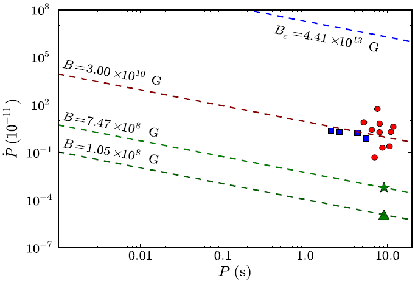
Figure 24: Rotation period derivative vs. the rotation period of SGRs and AXPs (red, blue, green). The dashed curves are contours of constant magnetic field, for a model based on white dwarfs.
Reproduced from Malheiro, Rueda, Ruffini, PASJ, 64, 56 (2012).
A further extension of the above treatment of white dwarfs to the case of finite temperatures has been part of the PhD work of S. M. de Carvalho. The inclusion of finite temperature effects is relevant in view of the recent discovery of ultra-low mass white dwarfs with masses. 0.2 M Sun , which are companion of neutron stars in relativistic binaries (Antoniadis et al., 2012, 2013). These low-mass white dwarfs represent the perfect arena for testing the equation of state of compressed matter since the central densities of these objects are of the order of 10 6 g cm -3 , where the degenerate approximation breaks down, thus thermal effects cannot be neglected. We have used this new equation of state to construct the mass-radius relation of white dwarfs at finite temperatures in a wide range of central densities. We analyze the particular case of the white dwarf companion of the pulsar PSR J1738+0333, which is expected to have a mass 0.18 M Sun (Antoniadis et al., 2012). Using the observed surface effective temperature and surface gravity of the white dwarf we have inferred the central temperature in the white dwarf core.
Regarding the structure properties of white dwarfs, it has been recently purported by Das & Mukhopadhyay (2013) that the presence of huge uniform magnetic fields of the order of 10 18 G, in the interior of a white dwarf, increases its maximum mass from the traditional Chandrasekhar value, 1.44 M Sun , to a new upper bound, 2.58 M Sun . Such a much larger limit would make these astrophysical objects viable candidates for the explanation of the superluminous population of type Ia supernovae. We have shown in (Coelho et al., 2014) that the new mass limit was obtained neglecting several macro and micro physical aspects such as gravitational, dynamical stability, breaking of spherical symmetry, general relativity, inverse b decay, and pycnonuclear fusion reactions. These effects are relevant for the self-consistent description of the structure and assessment of stability of these objects. When accounted for, they lead to the conclusion that the existence of such ultra-magnetized white dwarfs in nature is very unlikely due to violation of minimal requests of stability, and therefore the canonical Chandrasekhar mass limit of white dwarfs has to be still applied.
Progress has been also made in a formulation of the equations of equilibrium of neutron stars. We studied the construction of neutron stars within a fully consistent formulation equilibrium configurations in general relativity accounting for all the fundamental interactions. These neutron stars fulfill global but not local charge neutrality. The full system of equilibrium equations formed a coupled system that we have denominated Einstein-Maxwell-Thomas-Fermi (EMTF) equations. The solution of these new equilibrium equations leads to a markedly different mass-radius relation of neutron stars due to the different treatment of the boundary-value problem imposed by the core-crust transition. A crust of smaller mass and thickness is obtained (see Fig. 25 ). This work has been successfully generalized to the case of uniformly rotating neutron stars, and it has been part of the Ph. D. thesis of R. Belvedere, current Postdoc at ICRANet-Rio. The stability of neutron stars against mass-shedding and secular axisymmetric instabilities have been addressed. The analysis of the properties of the core-crust interface of a neutron star, such as its surface and Coulomb energies, and stability against perturbations have been studied by Y.~Wu and J. Pereira in their Ph. D. theses. This entire program has been developed in order to identify the initial boundary conditions for the electrodynamical process occurring at the onset of gravitational collapse leading to a black hole.
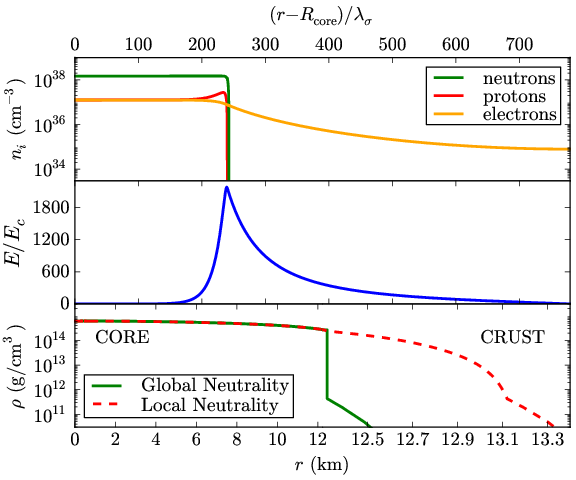
Figure 25 : The core-crust transition in a fully general relativistic treatment of a neutron star considering strong, weak, electromagnetic and gravitational interactions
Reproduced from Belvedere, Pugliese, Rueda, Ruffini, Xue, Nucl. Phys. A, 883, 1 (2012).
We have recently investigated in collaboration with Prof. C. A. Z. Vasconcellos and other Brazilian colleagues, extensions of the traditional sigma-omega-rho relativistic nuclear mean field model applied to the nuclear matter in neutron stars. We have introduced many-body correlations within a quantum hadrodynamics (QHD) model with parameterized couplings. We considered the whole fundamental baryon octet and the many-body forces are simulated by nonlinear self-couplings and meson-meson interaction terms involving scalar-isoscalar, vector-isoscalar, vector-isovector, and scalar-isovector.
Coming back to globally versus locally neutral neutron stars, there is the need of seeking for potential observations which could reveal the aforementioned new structure of the neutron star. Since the thermal evolution of a neutron star is strongly sensitive to its microscopic and macroscopic properties, one possibility to unveil the neutron star structure is represented by observing their cooling-down. Thus, we have recently computed in collaboration with S. M. de Carvalho, current Postdoc in University of Fluminense and ICRANet-Rio, and Prof. R. Negreiros from the University of Fluminense, the cooling curves of locally and globally neutral neutron stars. We have integrated numerically the energy balance and transport equations in general relativity, for globally neutral neutron stars with crusts of different masses and sizes, according to this theory for different core-crust transition interfaces. In the simulation we consider all the main radiation emissivities, heat capacity, thermal conductivity, and possible superconductivity of the nucleons. We found that the relaxation time depends upon the density at the base of the crust and, therefore, accurate observations of the thermal relaxation phase in the first years of evolution of newly-born neutron stars might give crucial information on the core-crust transition, probing the inner composition and structure of these objects.
Turning to neutron star astrophysics, we have also analyzed an interesting class of pulsars referred to as high-magnetic field pulsars, which are thought to be transition objects between pulsars and magnetars. The reason for this is that using fiducial values of mass M =1.4 M Sun , radius R =10 km, and moment of inertia I =10 45 g cm 2 for a neutron star, the magnetic fields inferred using the traditional magneto-dipole rotating model of pulsars appear to be very close and some of them even higher than the critical field of quantum electrodynamics, B c =2 m 2 e c 3 /( he ) =4.4x10 13 G. In addition, their X-ray luminosities appear higher than the rotational energy loss of the object, avoiding their explanation as rotation-powered pulsars. However, we have recently shown in (R. Belvedere,J. A. Rueda, R. Ruffini, to appear in ApJ) that the use of realistic parameters of rotating neutron stars obtained from numerical integration of the self-consistent axisymmetric general relativistic equations of equilibrium with realistic interior equation of state leads to values of the magnetic field and radiation efficiency of pulsars very different from estimates based on fiducial parameters. Furthermore, we compared and contrasted the magnetic field inferred from the traditional Newtonian rotating magnetic dipole model with respect to the one obtained from its general relativistic analog which takes into due account the effect of the finite size of the source. We have indeed shown that all the high-magnetic field pulsars can be described as canonical rotation-powered objects driven by the rotational energy of the neutron star, and with magnetic fields lower than the quantum critical field for any value of the neutron star mass (see Fig. 26).
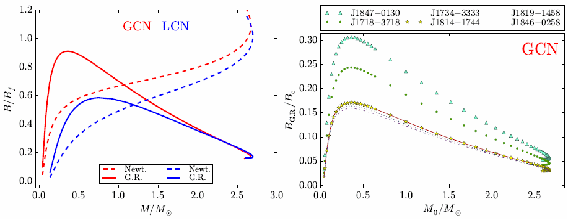
Figure 26: Left panel: ratio of the magnetic field (Newtonian and General Relativistic) to the magnetic field fiducial value. Right panel: magnetic field B G.R. of the high-magnetic field pulsars as obtained from the general relativistic magneto-dipole formula in units of critical magnetic field, as function of the mass (in solar masses), for static neutron stars in the global charge neutrality case.
Reproduced from Belvedere, Rueda, Ruffini, ApJ, in press (2014).
The understanding of the theory of neutron stars has allowed the analysis of their role in astrophysical systems such as the GRBs, the GRB-Supernova, and the short GRBs. It has been analyzed in detail the binary progenitors of these systems with particular emphasis on the role played by neutron stars.
Concerning the role of neutron stars in the induced gravitational collapse (IGC) paradigm of gamma-ray bursts (GRBs) associated with supernovae (SNe) Ic. The progenitor of those sources is a tight binary system composed of a carbon-oxygen (CO) core and a neutron star (NS) companion. The explosion of the SN leads to hypercritical accretion onto the NS companion, which reaches the critical mass, hence inducing its gravitational collapse to a black hole (BH) with consequent emission of the GRB. The first estimates of this process by Rueda and Ruffini (2012) were based on a simplified model of the binary parameters and the Bondi-Hoyle-Lyttleton accretion rate. We present new results in (Fryer et al., 2014) with the first full numerical simulations of the IGC phenomenon. We simulate the core-collapse and SN explosion of CO stars to obtain the density and ejection velocity of the SN ejecta. We follow the hydrodynamic evolution of the accreting material falling into the Bondi-Hoyle surface of the NS all the way up to its incorporation in the NS surface. The simulations go up to BH formation when the NS reaches the critical mass. For appropriate binary parameters, the IGC occurs in short timescales 10 2 – 10 3 s owing to the combined effective action of the photon trapping and the neutrino cooling near the NS surface (see Fig. 2 7 ). We also show that the IGC scenario leads to a natural explanation for why GRBs are associated only with SNe Ic with totally absent or very little helium.
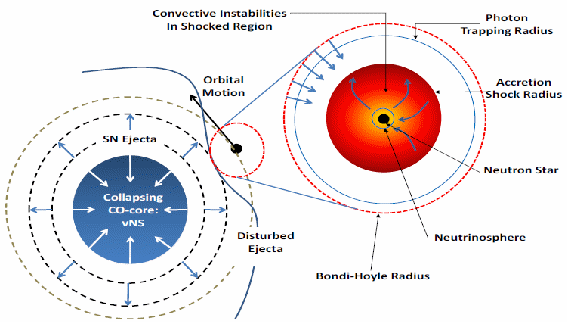
Figure 27: Sketch of the hypercritical accretion process within the IGC scenario.
Reproduced from Fryer, Rueda, Ruffini, ApJ, 793, L36 (2014).
Concerning short GRBs, we had the first example that they are the result of the merger of neutron star binaries. F. Gomes Oliveira, as part of her Ph. D. thesis, has computed the evolution of binary neutron stars up to the merger point to evaluate the emission of gravitational waves in these systems. The dynamics has been simulated via the effective one-body formalism of Prof. Thibault Damour, up to fourth post-Newtonian order. The detectability of this emission by second generation detectors such as Advanced LIGO has been assessed, and the total energy output in gravitational waves has been compared with the observed emission in both X and gamma rays. This work has been possible thanks to the analysis of the first genuinely short GRB 090227B by Muccino et al. (2013), where it has been shown that the properties of this GRB indeed are consistent with a binary neutron star progenitor.
Some of the above topics are leading to the preparation of a new book with Springer with the title “From the nuclei to the stars” by J. Rueda and R. Ruffini.
Papers published in 2014 include:
-
J.G. Coelho, R.M. Jr. Marinho, M. Malheiro, R. Negreiros, Jorge A. Rueda, R. Ruffini, “Dynamical Instability of White Dwarfs and Breaking of Spherical Symmetry Under the Presence of Extreme Magnetic Fields”, ApJ 794, 86 (2014).
-
Chris L. Fryer, Jorge A. Rueda, R. Ruffini, “Hypercritical Accretion, Induced Gravitational Collapse, and Binary-Driven Hypernovae”, ApJ Lett. 793, L36 (2014).
-
M. Razeira, A. Mesquita, C.A.Z. Vasconcellos, R. Ruffini, J.A. Rueda, R.O. Gomes, “Strangeness content of neutron stars with strong $\Sigma$-hyperon repulsion”, Astronomische Nachrichten 335, 739 (2014).
-
M. Razeira, A. Mesquita, C.A.Z. Vasconcellos, R. Ruffini, J.A. Rueda, R.O. Gomes, “Effective field theory for neutron stars with strong $\Sigma$-hyperon repulsion”, Astronomische Nachrichten 335, 733 (2014).
-
R. Ruffini, L. Izzo, M. Muccino, G. B. Pisani, J. A. Rueda, Y. Wang, C. Barbarino, C.L. Bianco, M. Enderli, M. Kovacevic, “Induced gravitational collapse at extreme cosmological distances: the case of GRB 090423”, A&A 569, A39 (2014).
-
Jonas P. Pereira, Herman J ~Mosquera-Cuesta, J. A. Rueda, R. Ruffini, “On the black hole mass decomposition in nonlinear electrodynamics”, Phys. Lett. B 734, 396 (2014).
-
F. G. Oliveira, J. A. Rueda, R. Ruffini, “Gravitational Waves versus X-Ray and Gamma-Ray Emission in a Short Gamma-Ray Burst”, ApJ 787, 150 (2014).
-
R. Ruffini, L. Izzo, M. Muccino, G. B. Pisani, J. A. Rueda, Y. Wang, C. Barbarino, C.L. Bianco, M. Enderli, M. Kovacevic, “On binary-driven hypernovae and their nested late X-ray emission”, A&A Lett. 565, L10 (2014).
-
J.A. Rueda, R. Ruffini, Y. Wu, S.-S. Xue, “Surface tension of the core-crust interface of neutron stars with global charge neutrality”, Phys. Rev. C 89, 035804 (2014).
-
S. M. de Carvalho, M. Rotondo, J.A. Rueda, R. Ruffini, “Relativistic Feynman-Metropolis-Teller treatment at finite temperatures”, Phys. Rev. C 89, 015801 (2014).
-
R. Belvedere, K. Boshkayev, J.A. Rueda, R. Ruffini, “Uniformly rotating neutron stars in the global and local charge neutrality cases”, Nucl. Phys. A 921, 33 (2014).
-
R. Belvedere, J.A. Rueda, R. Ruffini, “Static and rotating neutron stars fulfilling all fundamental interactions”, J. Kor. Phys. Soc. 65, 897 (2014).
-
K. Boshkayev, J.A. Rueda, R. Ruffini, I. Siutsou, “General relativistic white dwarfs and their astrophysical implications”, J. Kor. Phys. Soc. 65, 855 (2014).
-
S.M. de Carvalho, J.A. Rueda, R. Ruffini, “On the cooling of globally-neutral neutron stars”, J. Kor. Phys. Soc. 65, 861 (2014).
-
D.L. Caceres, J.A. Rueda, R. Ruffini, “On the stability of ultra-magnetized white dwarfs”, J. Kor. Phys. Soc. 65, 846 (2014).
-
K. Boshkayev, D. Bini, J.A. Rueda, A. Geralico, M. Muccino, I. Siutsou, “What Can We Extract from Quasiperiodic Oscillations?”, Gravitation and Cosmology 20, 233 (2014).
Supernovae (Page 1497)
GRBs have broaden the existing problematic of the study of Supernovae. In some models, e.g. the “collapsar” one, all GRBs are assumed to originate from supernovae. Within our approach, we assume that core-collapse supernovae can only lead to neutron stars, and we also assume that GRBs are exclusively generated in the collapse to a black hole. Within this framework, supernovae and GRBs do necessarily originate in a binary system composed by an evolved main sequence star and a neutron star. The concept of induced gravitational collapse leads to the temporal coincidence between the transition from the neutron star to the black hole and the concurrent transition of the late evolved star into a supernova. This very wide topic has been promoted by the collaboration with Prof. Massimo Della Valle, who is an Adjunct Professor at ICRANet and who is currently Co-PI of a VLT proposal “A spectroscopic study of the supernova/GRB connection”. This kind of research is particularly important for trying to find a coincidence between electromagnetic radiation, high-energy particles, ultra high-energy cosmic rays, neutrinos and gravitational radiation, possible observable for existing or future detectors. A short summary of the internationally well-known activities of Prof. Della Valle, who is an Adjunct Professor at ICRANet, is given in the report, which contains the many publications in international journals. Prof. Della Valle is also very actively following one graduate student of the IRAP PhD program. A new stimulus has come from the recent understanding of the IGC paradigm, which allows a completely new understanding of the relation between the supernovae and the GRBs.
Papers published in 2014 include:
-
Inserra, C. et al. 2014, MNRAS, 437, L51
-
Henze, M. et al. 2014, A&A, 563, 2
-
Dall'Ora, M. et al. 2014, ApJ, 787, 139
-
Melandri, A. et al. 2014, A&A, 567, 29
-
Tappert, C. et al. 2014, MNRAS, 442, 565
-
Kovacevic, M. et al. 2014, A&A, 569, 108
-
van Putten, M. et al. 2014, MNRAS, 444, L58
-
Barbarino, C. et al. 2014, A&A, in press. 2014arXiv1410.8393B
Symmetries in General Relativity (Page 1515)
This topic has been developed as an intense collaboration between various research groups. We had and we have the opportunity of the presence in Pescara of Prof. Roy Kerr as ICRANet Adjunct Professor and discussed the fundamental issues of the uniqueness of the Kerr-Newman Black Hole. A distinct progress in this collaboration has appeared in the paper by D. Bini, A. Geralico, R. Kerr, “The Kerr-Shild ansatz revised”, International Journal of Geometric Methods in Modern Physics (IJGMMP) 7 (2010), 693-703. Profs. R.T. Jantzen, L. Stella (Observatory of Monte Porzio, Rome), O. Semerak (Czech Republic), D. Bini and Dr. A. Geralico have studied the problem of motion of test particles in black hole spacetimes, in presence of a superposed radiation field. The scattering of radiation by the test particles causes a friction-like drag force which forces particles on certain equilibrium orbits outside the black hole horizon. This interesting effect, known as Poynting-Robertson effect, has been deeply investigated in many different contexts: besides the Schwarzschild and Kerr black hole, novel results have been published for the case of a Vaidya radiation metric. In the latter case, in fact, one takes the advantages of having an exact solution of the Einstein’s field equations whose source is a null field. Among the various consequences we mention that while a unique equilibrium circular orbit exists if the photon flux has zero angular momentum, multiple such orbits appear if the photon angular momentum is sufficiently high. Furthermore other solutions of the Weyl class with cylindrical symmetry as well as solutions within the class of exact gravitational plane waves and electromagnetic plane waves have been examined in the context of Poynting-Robertson like effects obtaining a number of physically relevant situations. Bini and Geralico have also considered the motion of spinning test particles in Kerr spacetime in full generality with the aim to study deviations between the world lines of spinning objects in comparison with those of geodesic test particles, generalizing some recent works on the same topic where motion were but constrained on the equatorial plane. Bini, Geralico and Jantzen have been able to obtain new foliations in spacetimes admitting separable geodesics. These “separable geodesic action slicing” have been used then to explore certain geometrical properties of horizon penetrating coordinates in black hole spacetimes. Other collaborations, again for what concerns the topics included in symmetries in General Relativity, have been started with Profs. A. Ortolan (INFN Legnaro, Padova, Italy) and P. Fortini (University of Ferrara, Italy) to study of the interaction of electromagnetic waves with gravitational waves, with the gravitational waves considered in the exact theory and not in its linear approximation.
Papers published in 2014 include:
-
Bini D., de Felice F., Geralico A., “On the spacetime acting as an optical medium: the observer-dependent approach”, IJGMMP, vol. 11 (3) 1450024 (15 pages) 2014.
-
Bini D., Geralico A., Haney M., “Refraction index analysis of light propagation in a colliding gravitational wave spacetime”, Gen. Relativ. Gravit. (2014) 46:1644.
-
Bini D., Geralico A., “Deviation of quadrupolar bodies from geodesic motion in a Kerr spacetime”, Phys. Rev. D. vol. 89 (4), 044013 (22 pages), 2014.
-
Bini D., Haney M., Geralico A., Ortolan A., “Deviation effects induced by strong electromagnetic waves”, Phys. Rev. D 89, 044013 (2014)
-
Bini D., Damour T., “High-order post-Newtonian contributions to the two-body gravitational interaction potential from analytical self-force calculations”, Phys. Rev. D 89, 064063 (2014)
-
Bini D., Geralico A., “Extended bodies in a Kerr spacetime: exploring the role of a general quadrupole tensor”, Class. Quantum Grav. 31 (2014) 075024.
-
Bini D., Geralico A., Gregoris D., Succi S., “Scalar field inflation and Shan-Chen fluid models”, Phys. Rev. D 90, 044021 (2014)
-
Bini D., Damour T., “Analytic determination of the eight-and-a-half post-Newtonian self-force contributions to the two-body gravitational interaction potential”, Phys. Rev. D 89, 104047 (2014).
-
Bini D., Esposito G., “Perturbative evaluation of scalar two-point function in the Cosmic Microwave Background power spectrum”, Phys. Rev. D, vol. 89, 084032, 2014.
-
Bini D., Damour T., “Two-body gravitational spin-orbit interaction at linear order in the mass ratio”, Phys. Rev. D 90, 024039 (2014)
-
Bini D., Mashhoon B., “Peculiar velocities in dynamic spacetimes”, Phys. Rev. D 90, 024030 (2014)
Self Gravitating Systems, Galactic Structures and Galactic Dynamics (Page 1629)
In collaboration with Campus Bio-Medico in Rome there are ongoing researches on galactic structures. The Reports is focused on analytical and numerical methods for the study of classical self-gravitating fluid/gaseous masses. A series of papers of this group have been devoted in the past to the generalization of the classical theory of ellipsoidal figures of equilibrium using virial methods. The research activities of the group have focused subsequently on functional methods for obtaining equilibrium solutions for polytropic self-gravitating systems that rotate and have a non uniform vorticity. The group has recently published a novel and important result in the context of analogous geometry theory. It is well known that the wave equation for the perturbations of given a perfect barotropic and irrotational Newtonian fluid can be rewritten as an “effective General Relativity”. They have extended this result including the possibility for the fluid to be self-gravitating. This work opens the path for a new interpretation of classical white-dwarf theory in terms of curved space-time techniques. The group has also studied the perturbations of classical compressible rotating but not gravitating fluids as occurring in generalized acoustic black holes. It has also analyzed the Analog Gravity formalism at full nonlinear level through Von Mises’ Wave Equation for irrotational configurations.
Interdisciplinary Complex Systems (Page 1659)
We recall the successful attempt of applying methodologies developed in Relativistic Astrophysics and Theoretical Physics to researches in the medicine domain. The Report adopts analytical and numerical methods for the study of problems of nonlinear dynamics focusing on biological systems and using a theoretical physics approach. It is well established both numerically and experimentally that nonlinear systems involving diffusion, chemotaxis, and/or convection mechanisms can generate complicated time-dependent spiral waves, as in happens in chemical reactions, slime molds, brain and in the heart. Because this phenomenon is global in Nature and arises also in astrophysics with spiral galaxies, the goal of this research activity has been to clarify the role of this universal spiraling pattern. The group has studied numerically the nonlinear partial differential equations of the theory (Reaction-Diffusion) using finite element methods. The group has recently published moreover a novel and important result: an electromechanical model of cardiac tissue, on which spiral moves and causes the domain to deform in space and time (see Fig. 28). This model is a real breakthrough in the context of theoretical biophysics, leading to new scenarios in the context of computational cardiology. In 2014 the group has focused its research on classical hydrodynamics, evaluating the stress exerted by the fluid on the domain walls and introducing an indicator of risk for their damage. Such a methodology, named as “three-band decomposition analysis of wall shear stress in pulsatile flows”, has been immediately applied to hemodynamical problems which have been numerically integrated (see Fig. 29), but results promising also for other problems of physical and biological sciences and for engineering.
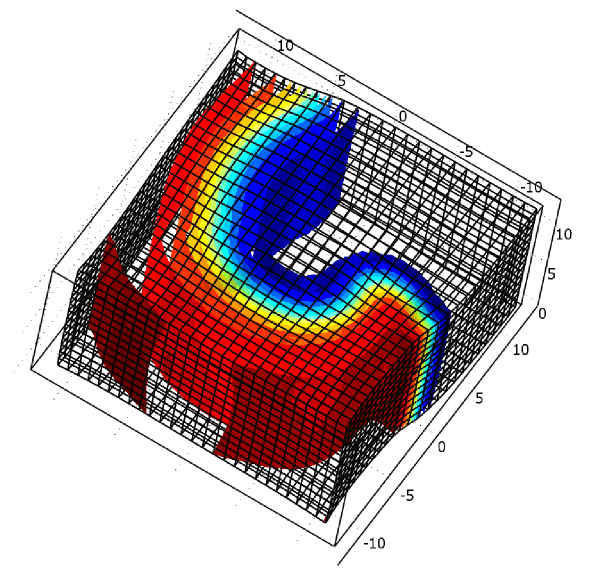
Figure 28: Electrical activity map of an electro-elastic deformed patch of cardiac-type tissue.
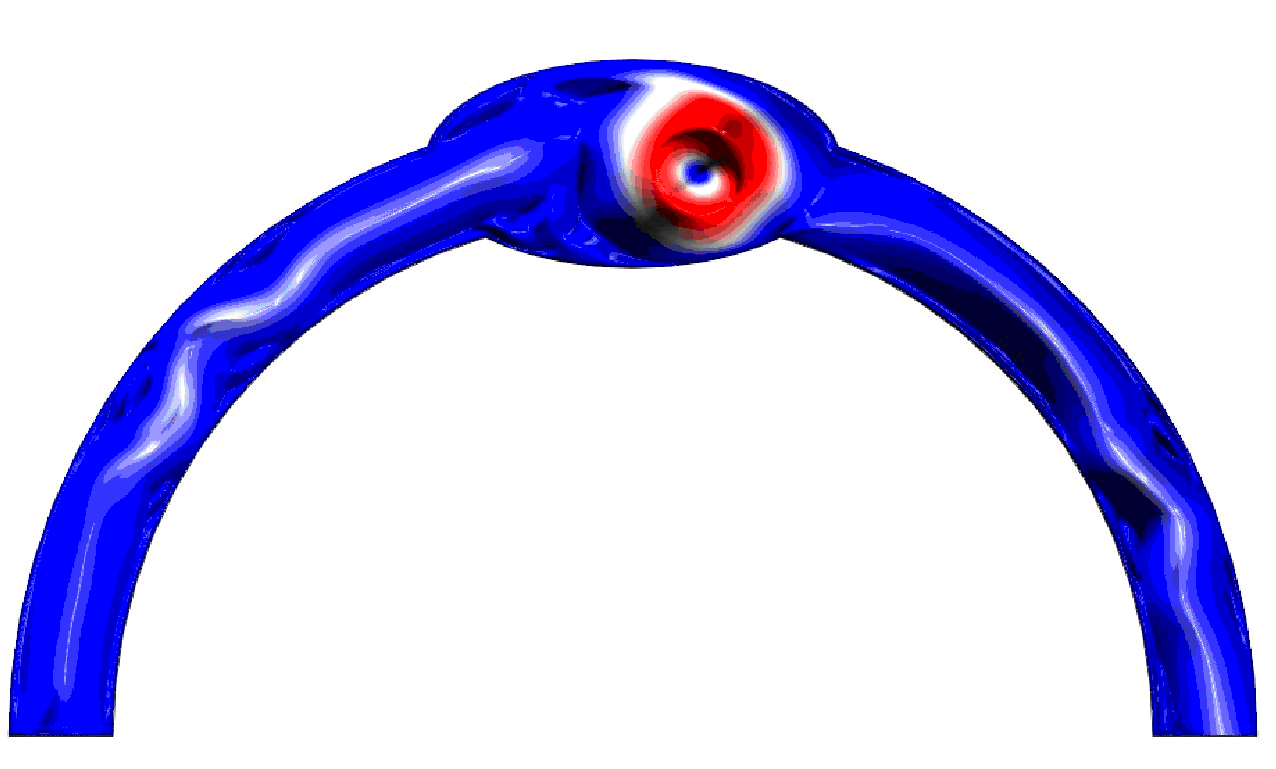
Figure 29: Turbulent flow structure (specifically the velocity amplitude) in a deformed vessel, obtained by numerical integration through finite elements of the incompressible Navier-Stokes equations.
Papers published in 2014 include:
-
R. Ruiz-Baier, A. Gizzi, S. Rossi, C. Cherubini, A. Laadhari, S. Filippi and A. Quarteroni, “Mathematical modeling of active contraction in isolated cardiomyocytes”, Mathematical Medicine and Biology (2013), 31(3):259-83 (2014)
-
S. Filippi, A. Gizzi, C. Cherubini, S. Luther. and F H. Fenton "Mechanistic insights into hypothermic ventricular fibrillation: the role of temperature and tissue size" Europace 16, 424–434 (2014)
-
Loppini A., Capolupo A., Cherubini C., Gizzi A., Bertolaso M., Filippi S., Vitiello G. "On the coherent behavior of pancreatic beta cell clusters" Physics Letters A Volume 378, Issue 44, Pages 3210–3217 (2014)
-
Giuliani, A , Filippi, S, Bertolaso, M, "Why network approach can promote a new way of thinking in biology" Frontiers in Genetics Volume 5, (2014), Article number Article 83.
-
Altomare, A., Gizzi, A., Guarino, M.P.L., Loppini, A., Cocca, S., Dipaola, M., Alloni, R., Cicala, M., Filippi, S., "Experimental evidence and mathematical modeling of thermal effects on human colonic smooth muscle contract", American Journal of Physiology - Gastrointestinal and Liver Physiology Volume 307, Issue 1, 1, Pages G77-G88 (2014)
An important fundamental research topic is the investigation of “analogue models of gravity”. Such models have been used to understand many aspect of gravitational phenomena, in particular the mechanism of Hawking- and Unruh-Radiation, by studying in supersonic flow nozzles. These were of great help in dispersing criticism of these radiations based on our ignorance of the divergences of local quantum field theory at ultrashort distances. Another important analogy is bases on the relation between Einstein-Cartan Physics and the theory of defects in solids, worked out in detail in the textbook by our adjunct faculty members H. Kleinert: <http://users.physik.fu-berlin.de/~kleinert/kleinert/?p=booklist&details=1>. This analogy has recently allowed to understand the equivalence of Einstein's theory of gravitation with his Teleparallel Theory of Gravitation as a result of a novel gauge symmetry. The first uses only the curvature of spacetime to explain gravitational forces, while the second uses only torsion. The equivalence relies on the fact that crystalline defects of rotation and translation (disclinations and dislocations, respectively) are not independent of each other, but the ones can be understood as superpositions of the other. Moreover, the analogy has allowed to set up an infinite family of intermediate theories in which curvature and torsion appear both <http://klnrt.de/385/385.pdf>. Finally, all geometries relevant in gravitational physics has been derived from a completely new theory of multivalued fields <http://www.physik.fu-berlin.de/~kleinert/kleinert/?p=booklist&details=9>.
The volume: Einstein, Fermi and Heisenberg, and the birth of relativistic astrophysics is being completed by R. Ruffini with contributions by Emanuele Alesci, Donato Bini, Dino Boccaletti, Andrea Geralico, and Robert T. Jantzen . This book has some different goals: 1 ) to translate into English a set of papers by Fermi which were available only in Italian; 2 ) to try to understand the reason why, having been one of the greate st experts on Einstein theory in the earliest years of his life, after his transfer to Rome and later on to the United States Fermi never published anything on Einstein theory: the only paper by Fermi treating general relativity and cosmology was written to prove George Gamow wrong and Einstein theory not proper to the analysis of cosmology – on the contrary, the work of Fermi turned out to be the real starting point of modern relativistic cosmology and proved the validity of Gamow theory and of course of the Einstein theory of general relativity; 3) the book also endures on the difficult dialogue between Einstein and Heisenberg, with some personal reminiscence, and illustrates how all the developments of the last 50 years have been essentially based on their work as well as on the one of Fermi.
Other books are:
1. J. Einasto, “Dark Matter and Cosmic Web Story”, World Scientific, 2014.
2. J. Rueda and R. Ruffini, “Von Kernen zu den Sternen”, Springer, expected in 2015.
3. R. Ruffini, G.V. Vereshchagin and S.-S. Xue, “Oscillations and radiation from electron-positron plasma”, World Scientific, expected in 2015.
4. V. Belinski and E. Verdaguer, “Gravitational Solitons”, Second Edition, Cambridge University Press, expected in 2015.
5. V. Belinski, “Cosmological Singularity”, Cambridge University Press, expected in 2015.
6. D. Bini, S. Filippi and R. Ruffini, “Rotating Physical Solutions”, Springer, expected in 2015.
7. C.L. Bianco, L. Izzo, R. Ruffini and S.-S. Xue, “The Canonical GRBs”, World Scientific, expected in 2015.
8. H.C. Ohanian, R. Ruffini, “Gravitation and Spacetime”, Third Edition, Norton and Company, 2013.
An oral presentation by Pascal Chardonnet of the current situation of the IRAP PhD and the Erasmus Mundus program co-sponsored by the European Commission, as well as a report on the first 28 graduate students enrolled in the program (see enclosure 7).
In 2015 ICRANet will actively participate to the celebration of the International Year of Light under the aegis of UNESCO celebrating the 100th Anniversary of the Einstein Equations and the Golden Jubilee of Relativistic Astrophysics. The main event will be represented by the MG XIV Meeting to be held at the University of Rome “La Sapienza” from the 12th to the 18th of July 2014 (see Fig. 30), as well by a series of satellite meetings: in Yerevan (Armenia) the “1st ICRANet Benjamin Markarjan Meeting” from the 20th to the 23rd of January; in Rio de Janeiro (Brazil) the “2nd ICRANet Cesare Lattes meeting”; in Nice (France) the “4th Bego Rencontre” from the 7th to the 18th of September; in Hofei (China) the “4th Galileo – Xu GuangQi Meeting” from the 22nd to the 27th of November; in Mexico City (Mexico) the “1st ICRANet Sandoval Vallarta Meeting” from the 1st to the 5th of December. ICRANet is also currently organizing a celebration in New York in December concluding the International Year of Light at the UN in collaboration with the New York Academy of Sciences and the representatives of the ICRANet Member States.
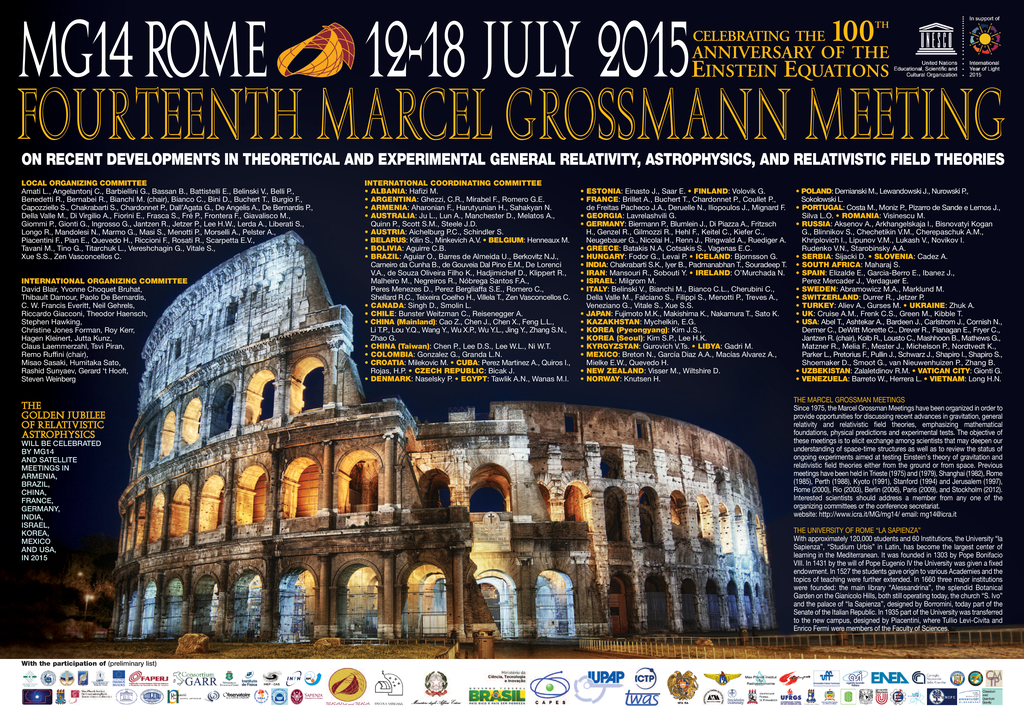
Figure 30: Poster of the MG XIV Meeting
Acknowledgements
I am very happy to express, on behalf of all the Members of ICRANet and myself, our profound gratitude to the Ministers of Foreign Affairs, and to the Ministers of Economy and Finances, of Armenia, Brazil and Italy, and to the Vatican Secretary of State, as well as to the Presidents of the University of Arizona in Tucson, of the Stanford University, and of ICRA.
We are particularly grateful to the Brazilian Ambassador in Rome, H.E. Ricardo Neiva Tavares, and to Dr. Ademar Seabra Da Cruz of Itamaraty , just appointed representative of Brazil in the ICRANet Board, as well as to the Scientific Attaché in Rome Dr. Luiz Felipe Czarnobai. We are equally grateful to the Armenian Ambassador in Rome, H.E. Mr. Sargis Ghazaryan, and to Min. Roberto Cantone, Dr. Alessandra Pastorelli and Prof. Immacolata Pannone, of the Italian Ministry of Foreign Affairs and International Cooperation. Their continuous assistance has led, among others, to the approval of the Seat Agreements by the President of Brazil and by the President of Armenia.
Special gratitude to the State Committee of Science of Armenia, to the Ministério do Planejamento, Orçamento e Gestão of Brazil, and to the Ragioneria Generale of the Ministry of Economy and Finances of Italy, for their attention in the activities of ICRANet.
A special recognition goes to the activities of the many Ambassadors and Consuls who have greatly helped in the intense series of activities carried out by ICRANet in Armenia, Belarus, Brazil, France, China, Korea and New Zealand.
This year has been marked by an intense series of lectures organized by ICRANet at the University of Nice Sofia Antipolis for the graduate students and by the completion of the seat of Villa Ratti in Nice. We are grateful for this common effort to the President, Frédérique Vidal, and the Vice President, Stéphane Ngô Maï, of the University of Nice Sofia Antipolis. We are grateful to the Mayor of Pescara, Marco Alessandrini, to the Mayor of Nice, Christian Estrosi, to the Adjunct for Science, Research and Culture, Dr. Agnes Rampal, and to the President of the Conseil Général des Alpes-Maritimes, Eric Ciotti, for their generous support in granting to ICRANet the logistics of the Centers in their respective townships.
Clearly, a special mention of satisfaction goes to all the Scientific Institutions and Research Centers which have signed with us a collaboration agreement which include ASI (Italian Space Agency, Italy), BSU (Belarusian State University, Belarus), CAPES (Brazilian Fed. Agency for Support and Evaluation of Grad. Education), CBPF (Brazil), State Government of Ceará (Brazil), CNR (National Research Council, Italy), ENEA (National Agency for new technologies, energy and the economic sustainable development, Italy), FAPERJ (Fundação Carlos Chagas Filho de Amparo à Pesquisa do Estado do Rio de Janeiro, Brazil), GARR (Italy), ICTP (The Abdus Salam International Center for Theoretical Physics, Italy), IHEP (Institute of High Energy Physics, Chinese Academy of Sciences, China), IHES (Institut des Hautes Études Scientifiques, France), INFN (National Institute for Nuclear Physics, Italy), INPE (Instituto Nacional de Pesquisas Espaciais, Brasil), ITA (Instituto Tecnológico de Aeronáutica, Brazil), LeCosPa (Leung Center for Cosmology and Particle Astrophysics, Taiwan), NASB (National Academy of Sciences, Belarus), NAS RA (National Academy of Science, Armenia), Nice University Sophia Antipolis (France), Pescara University “D’Annunzio” (Italy), SCSA (State Committee of Science of Armenia), UAM (Universidad Autónoma Metropolitana, México), UERJ (Rio de Janeiro State University, Brazil), UFF (Universidade Federal Fluminense, Brazil), UFPB (Universidade Federal da Paraíba, Brazil), UFPE (Universidade Federal de Pernambuco, Brazil), UFRGS (Universidade Federal do Rio Grande do Sul, Brazil), UFSC (Universidade Federal de Santa Catarina, Brazil), UIS (Universidad Industrial de Santander, Colombia), UNAM (Universidad Nacional Autonoma De Mexico), UNIFEI (Universidade Federal de Itajubà, Brazil), University of Rome “Sapienza” (Italy), UNS (Universidad Nacional del Sur, Argentina).
ICRANet, as sponsor of the IRAP-PhD program, expresses its gratitude to AEI – Albert Einstein Institute – Potsdam (Germany), Bremen University (Germany), Carl von Ossietzky University of Oldenburg (Germany), CBPF – Brazilian Centre for Physics Research (Brazil), Ferrara University (Italy), IHES (France), Indian centre for space physics (India), INPE (Instituto Nacional de Pesquisas Espaciais, Brasil), Nice University Sophia Antipolis (France), Observatory of the Côte d'Azur (France), Rome University – “Sapienza” (Italy), Savoie University (France), Shanghai Astronomical Observatory (China), Stockholm University (Sweden), Tartu Observatory (Estonia), for their joint effort in creating and activating this first European Ph.D. program in Relativistic Astrophysics which has obtained the official recognition of the Erasmus Mundus program of the European Community. All these activities were achieved thanks to the dedicated work of Prof. Pascal Chardonnet.
Finally, thanks goes to the Physics Department of the University of Rome “Sapienza” for all the collaboration with ICRA in the teaching, in the electronic links and in the common research.
A special mention of gratitude, of course, goes to the administrative, secretarial and technical staff of ICRANet and ICRA for their essential and efficient daily support.